Grimaldi, Part 1: Buenos Aires up the Brazilian Coast
— Grimaldi, Sailing — 16 min read
February 17 - 23, 2011

When I told my father about this trip, one of his first questions was how was I going to cross the Atlantic Ocean. No problem, dad; there's this cargo boat that takes passengers and their vehicles from South America to Europe. In the route planning stages of the trip, I decided on a route back to India with as little shipping and transporting of the bike as possible as that's usually an expensive event, and I also wanted to stay on the surface of our planet and not take any shortcuts (airplanes) to promote the idea of slow travel. Besides the Darien Gap, crossing the Atlantic was the big shipping event and after following Brian and Marie on their 2upRTW journey, I was glad to see that traveling with Grimaldi Lines and their freighter cruises would be an excellent option.
After Argentina, I wanted to enter Africa in Morocco and go down the west side to follow the dry seasons around the continent (this plan would later change due to visa issues). The fastest option would be to air freight the bike to Spain and fly there myself, but that's no fun and too fast. The next option would be to send the bike as crated cargo via ship and fly to meet the bike. Again, not exciting and I didn't want to deal with crated cargo and customs brokers on either side. The last option was to use Grimaldi Lines and their Ro/Ro (roll-on/roll-off) ships to transport the bike and myself across the Atlantic. This option would give me the unique experience of traveling by sea; crossing an ocean on a cargo ship. A first for me and I was super excited about this part of the journey. All three options probably cost the same in the end.
Grimaldi Lines is an Italian shipping company, based in Naples, with a fleet focused on Ro/Ro cargo and numbering up to 85 ships across their group. They are primarily focused on the European market and run many services to Africa and luckily for us overlanders, there's a South America to Europe service. The ships on that line are of the multi-purpose category because they can also take on regular containers along with rolling cargo (vehicles). Because they take rolling cargo, opposed to regular cargo ships, overlanders can simply drive their vehicles onto the ship, avoiding the hassle of crating the vehicles. And since Grimaldi runs passenger ferries across Europe and is experienced with passengers, they allow up to 12 passengers per cargo ship to make the journey. They take only 12 passengers, because if a ship has more than that, they are required by international maritime law to carry a doctor on board with medical facilities and since they are working cargo ships, they can't afford the space on board for that and I presume, don't want to pay for a doctor. So, when you book your ticket, you sign a liability waiver saying that if anything happens to you while out at sea, it's your responsibility.
When you take your personal vehicle with you, it's basically considered as oversize luggage and the cost of transporting a bike across the Atlantic is €340 ($487). The passenger cost for a single traveler is €2,006 ($2,873) and it's a little cheaper if a couple is traveling since a single traveler is required to pay for the whole cabin. For the 26 day journey from Buenos Aires to Hamburg, that comes out to about €90 (\$129) per day, which is not a bad deal considering you get a private room, 3 big meals a day and transport for your bike across the ocean. Plus, the awesome experience of traveling across an ocean. One of my close childhood friends, now working as an investment banker in Frankfurt, offered to pay for my journey across the Atlantic and that greatly helped my trip budget. I had helped him out earlier when times were rough and he was looking out for me now. And besides, what's a couple thousand between friends :)
To make a reservation from Buenos Aires, contact Ines (oper@turner.com.ar) who is very responsive and helpful.
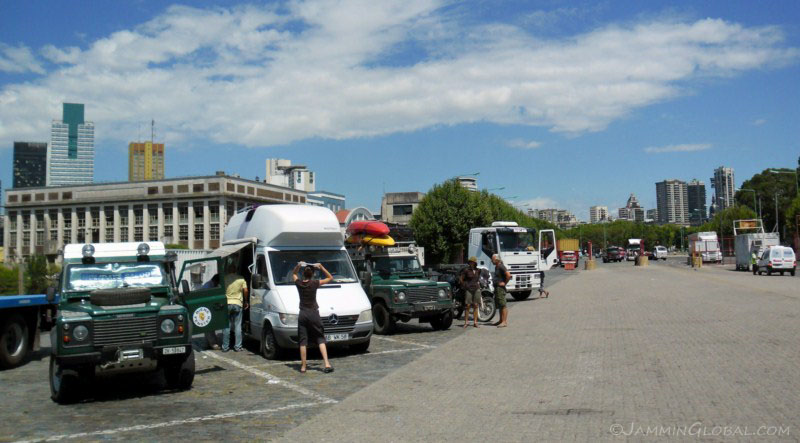
On the day of departure, February 17, 2011, I rolled into the Buenos Aires Cargo Terminal, which is very close to downtown and met my fellow passengers who were heading back home after their trips around South America. I also filled up my bike with cheap Argentine petrol, since it costs half as much as in Europe.
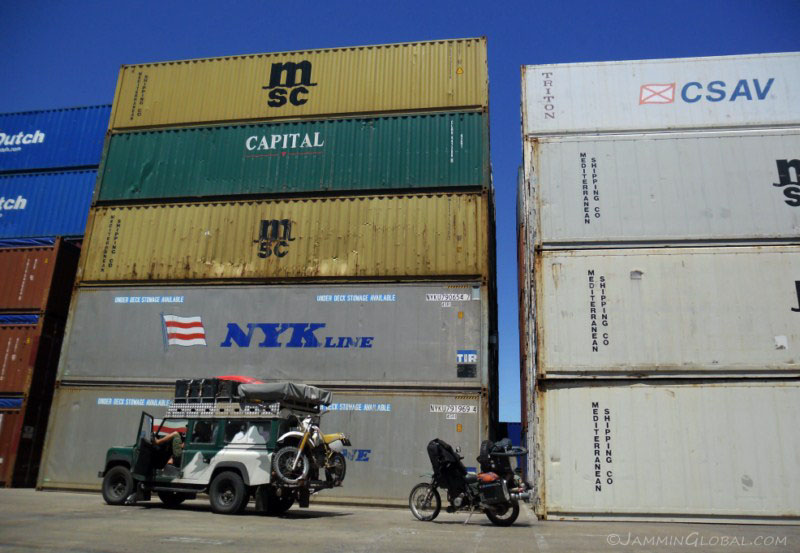
There was a lot of waiting around in the hot sun and after the Grimaldi agent met us, we were taken for a 'tour' of the port, waiting at a few different places. Initially, none of us knew what we were waiting for or what was going to happen, but we were all happy to be in the port and eagerly awaited the moment we could enter the ship. This is Franz and Sandra, who just did a four month tour of southern South America in their LandRover Defender. Franz runs an outdoor shop in southern Germany and is traveling in style with a Suzuki DR350 on the back and two canoes on top.
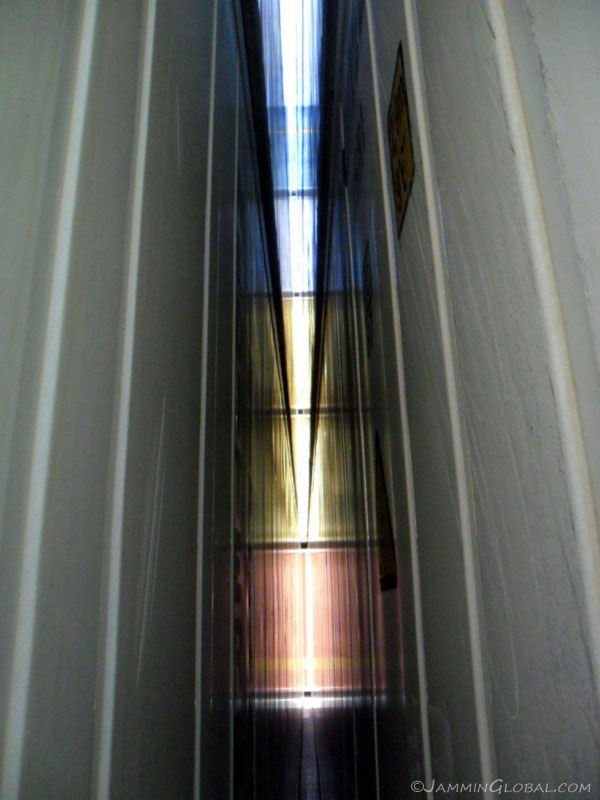
While seeking refuge from the sun in between the container walls, I spotted this nice play on perspective and colors of containers on the other end.
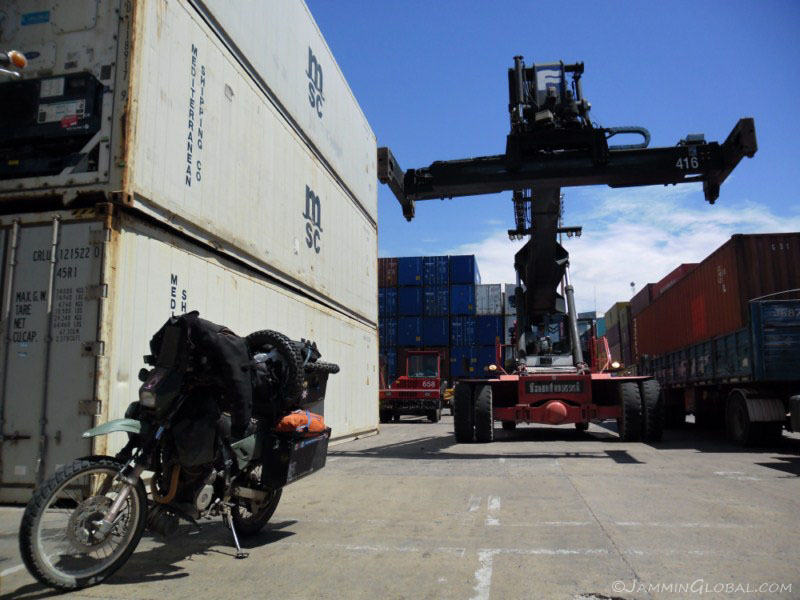
A cargo terminal is a busy place and we had to move out of the way of this container mover.
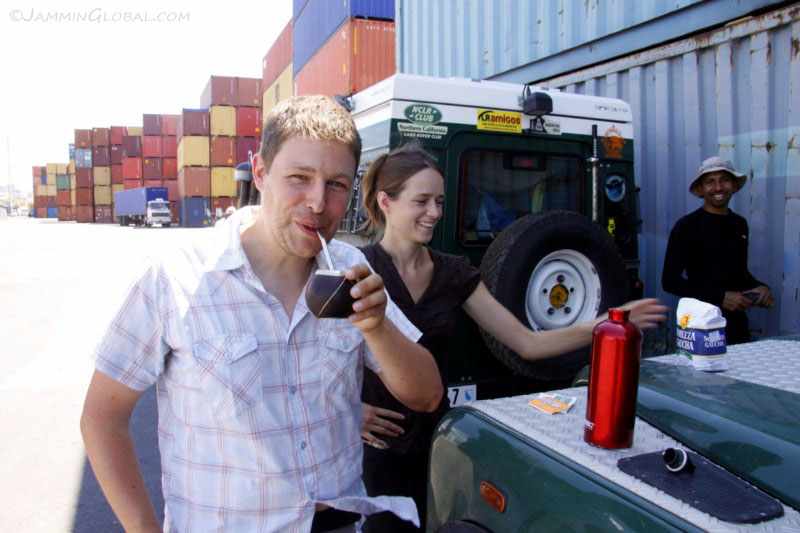
This is Michael and Käthi from Switzerland who are returning home after a two year trip down the Americas in the other green Defender. They left with a good taste of yerba maté from Argentina and to while away the time, waiting for whatever was going to happen next, we shared a round of the hot, bitter drink.
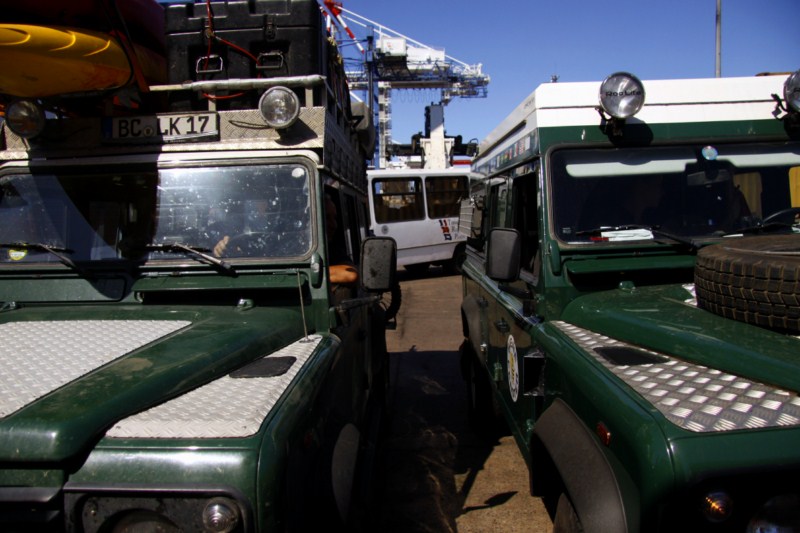
'Green LandRover Defender Parking Only'
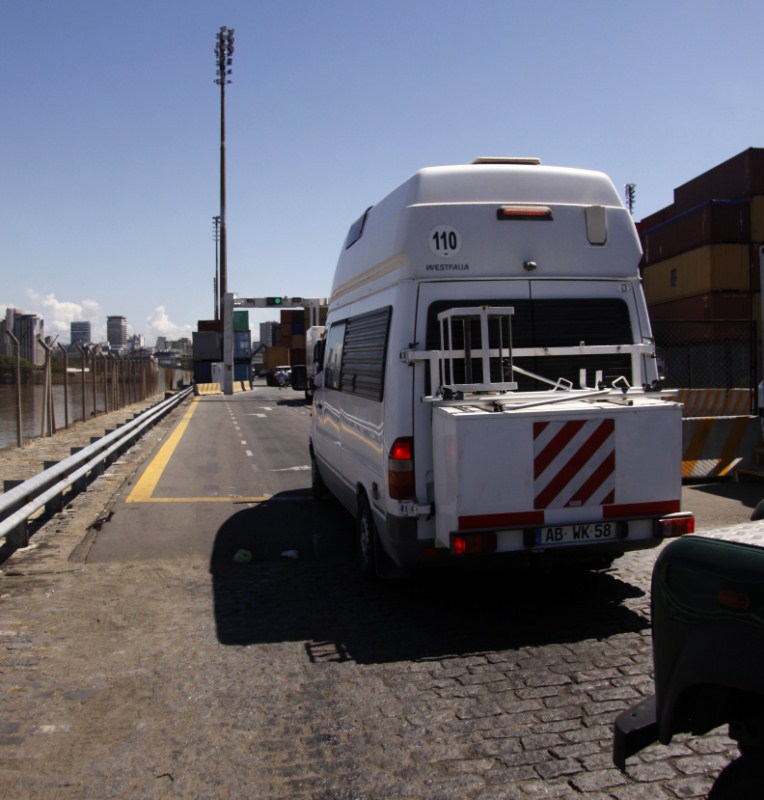
Ah, this is what we were waiting for - giving the vehicles an x-ray scan from a mobile scanner, which is standard procedure in ports around the world. They're looking for hidden compartments and weapons and other such items.
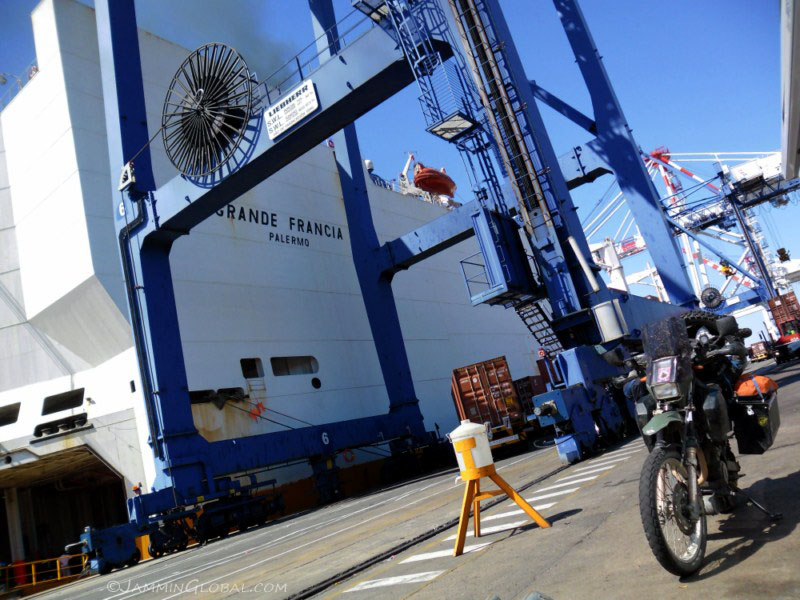
After the scan, we finally caught sight of our home for the next few weeks...
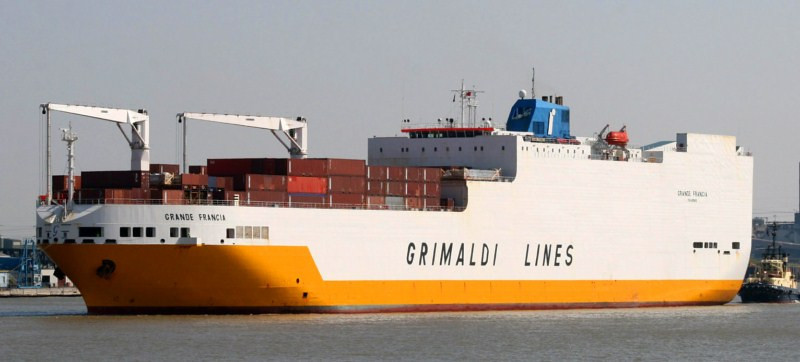
The Grande Francia, a 214 m (702 ft) long multi-purpose Ro/Ro cargo ship, with a capacity to transport 2,500 vehicles and 800 containers. She's part of the Grande Africa Class of Grimaldi ships and was put into service in 2002.
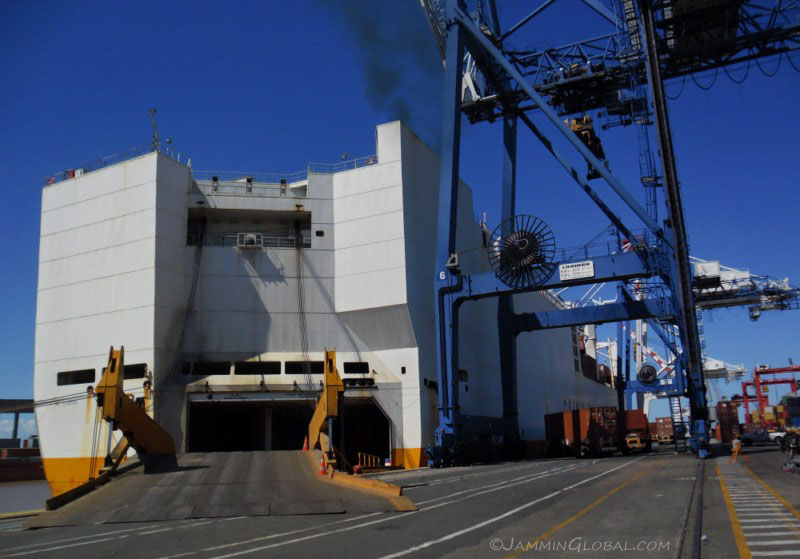
The unique feature of these kind of ships is the angled rear ramp that allows for vehicles to roll on board.
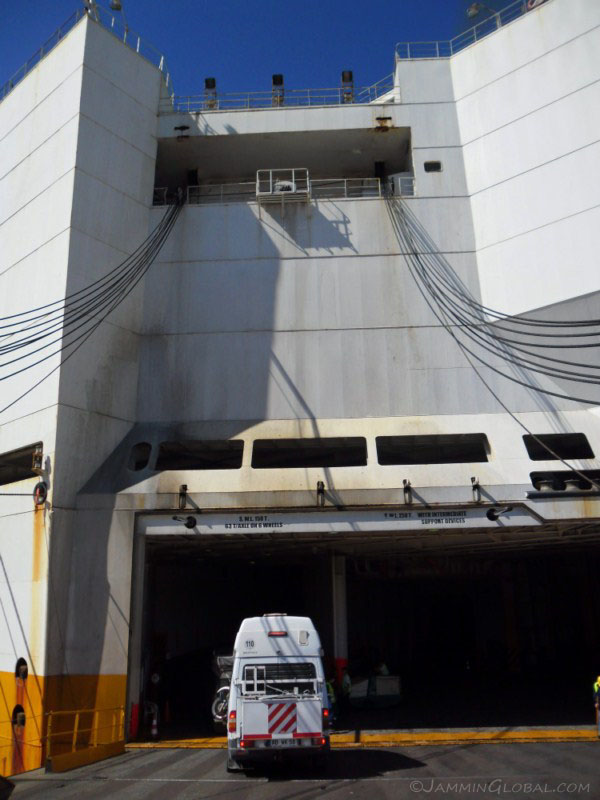
Klaus, in his Mercedes camper van, entering the ship and me, following behind.

Once on board, we were directed to the 6th deck and Nolan here, a Filipino crew mate, tied down sanDRina securely and helped me carry everything off the bike and up to our cabins on the 12th deck.
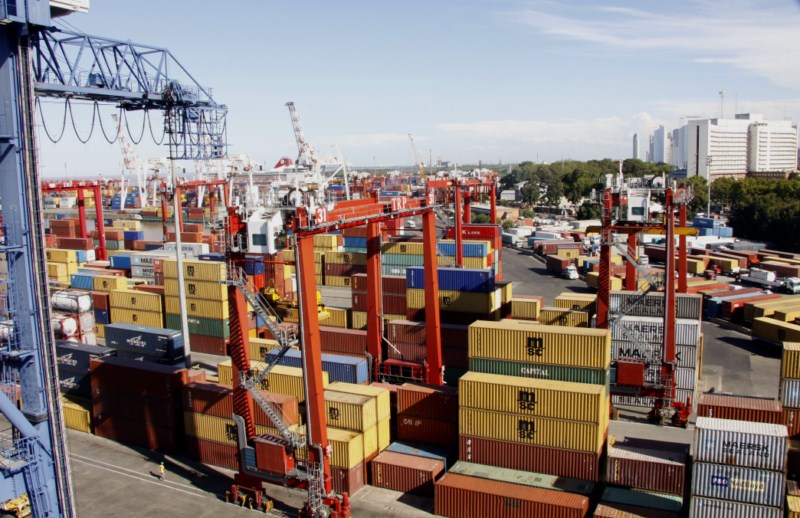
After settling in to our rooms, we all got on the top deck to waive goodbye to Buenos Aires.
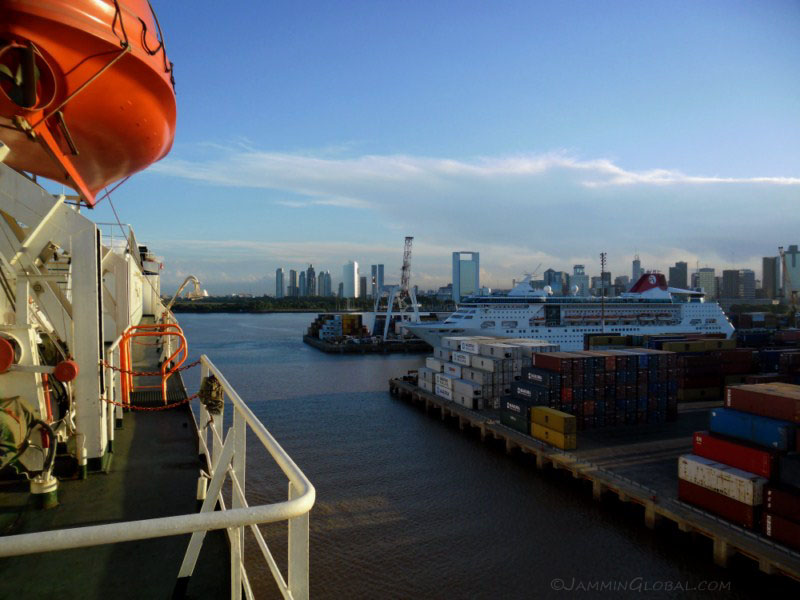
The ship set sail around 7 pm and we were moving quite quickly right away.
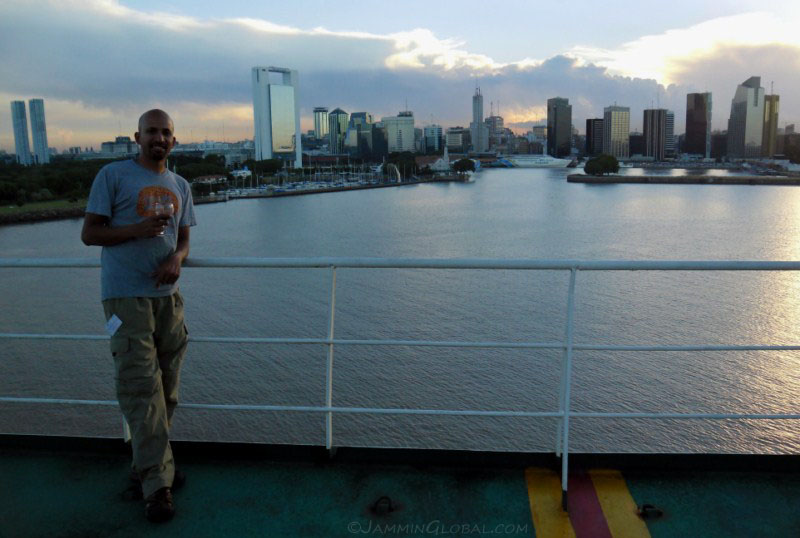
With a glass of red wine from dinner, I bid farewell to Argentina and my marvelous ride thru South America. Lots of wonderful experiences passed in this beautiful continent and I hope to return one day to explore it further. Ciao!
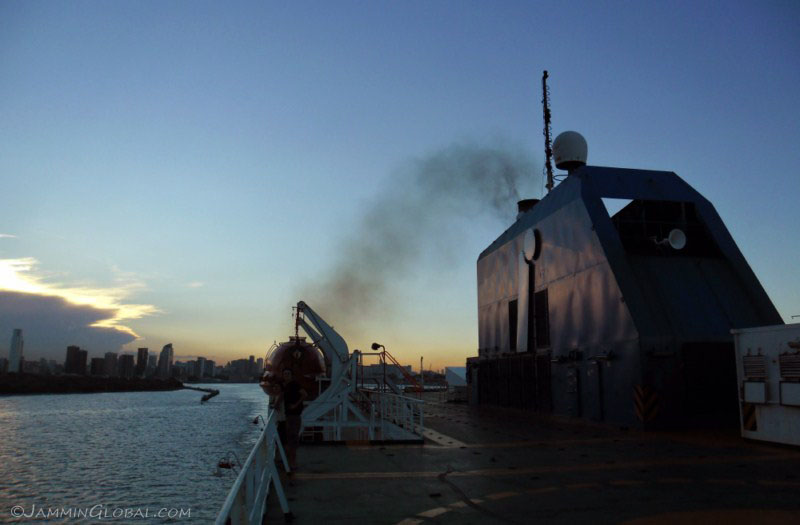
Powering out of port and heading to the open sea.
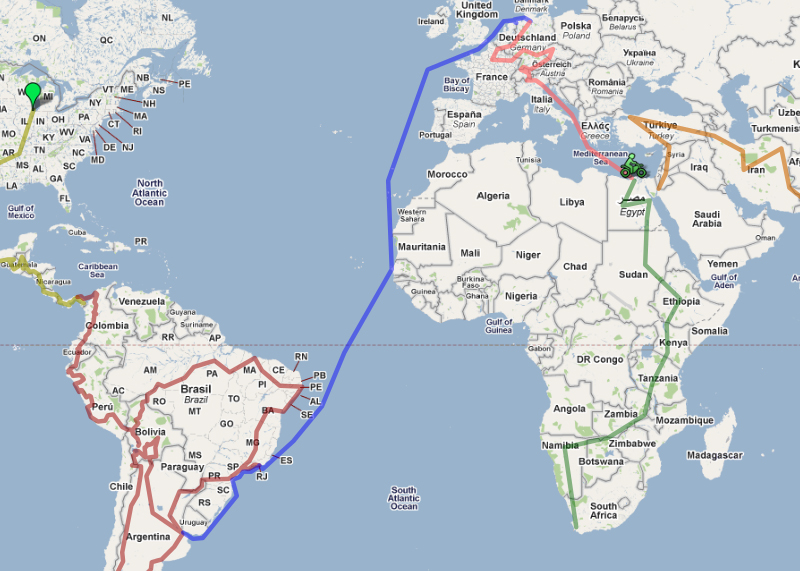
The route map of the ship's 12,000 km (7,450 mi) journey from Buenos Aires, up the Brazilian coast, across to Africa, then up to Hamburg, Germany over 26 days. Click on it to go to the interactive version in Google Maps.
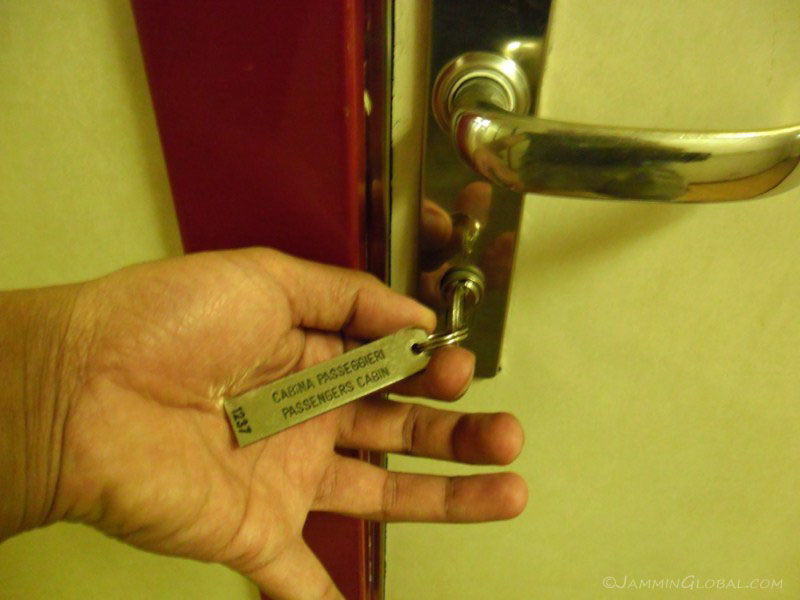
I was excited as this was my first journey on a ship (besides the 5 days on the Stahlratte).
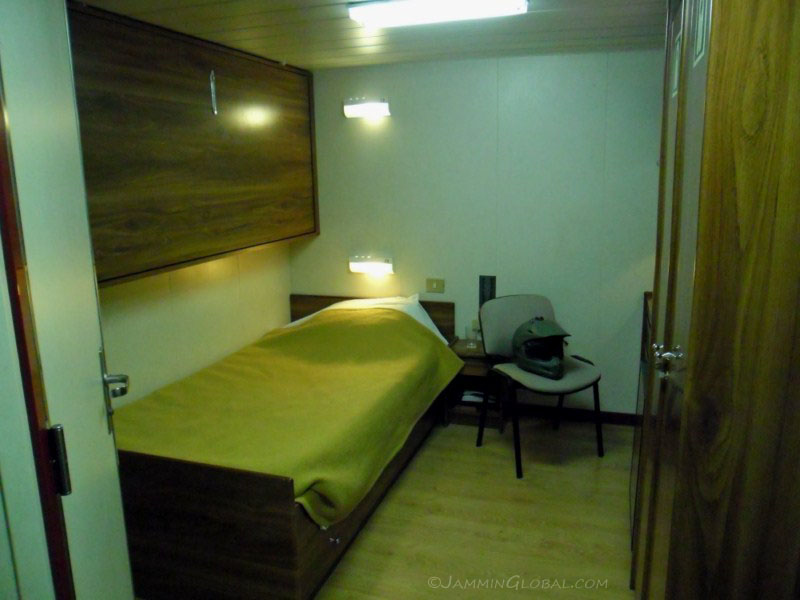
My cabin, which was very comfortable, but had no windows, since having a room with one cost a few hundred more euros. If there were two people sharing this room, then the upper bed would be folded down and I think that would make the room feel much smaller.
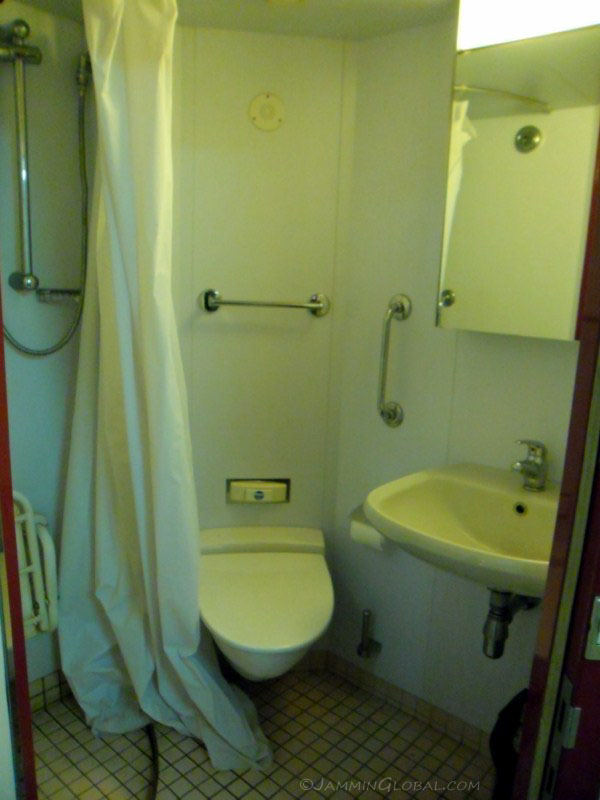
The spacious-enough bathroom.
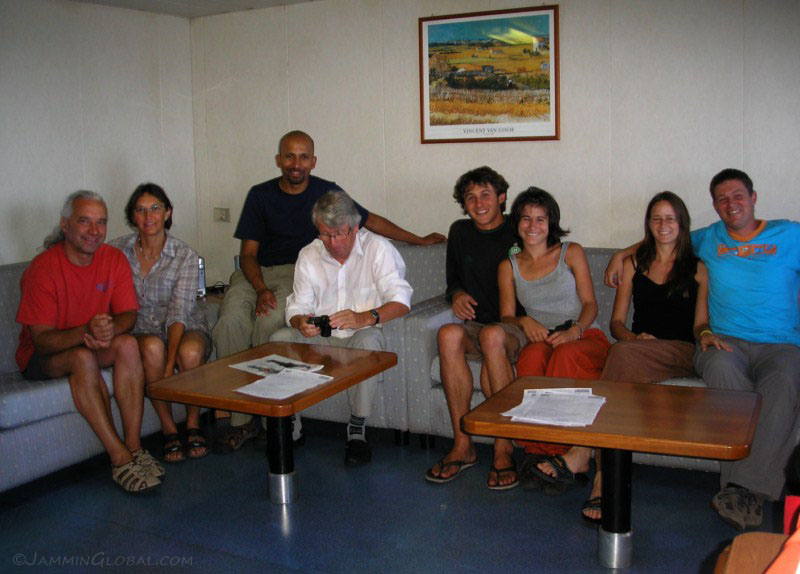
A shot of the passengers with Franz and Sandra on the left, me, Klaus (a German biologist who traveled all over the Americas), Anthony and Marie (a French couple returning from a year of study abroad in Buenos Aires) and Käthi and Michael, whom I connected with the most.
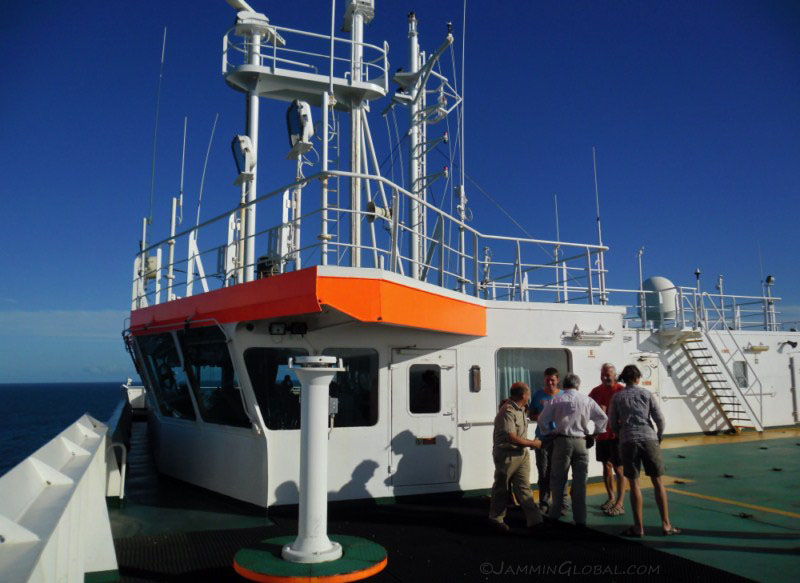
The next day, we were given a safety briefing by the Second Mate, Officer Mantilla, who is in charge of all the security issues on the ship. We just had a tour of the bridge, the ship's command center.
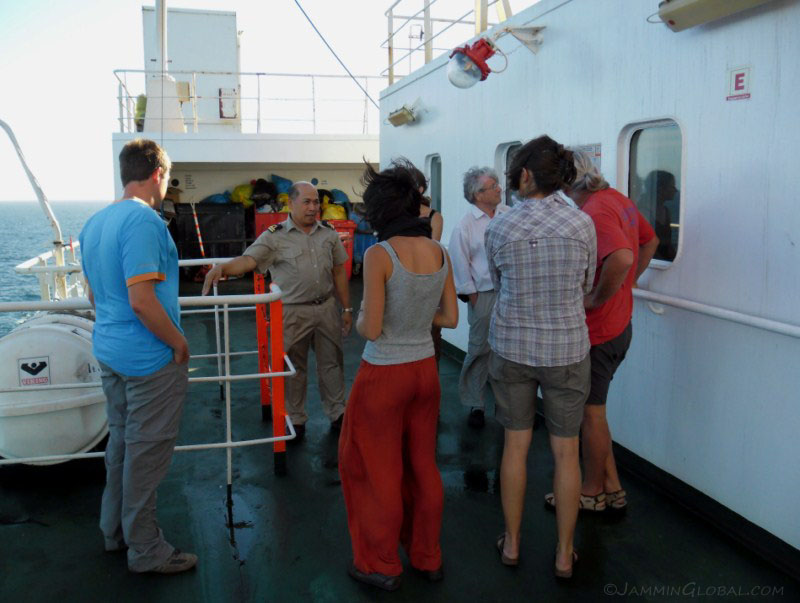
He informed us of all the lifeboats on board and the procedure to follow when the fire drill alarm was sounded. It was very windy just offshore from Uruguay. The white container he's pointing at has an explosive lock on it that will release an inflatable raft if it detects the ship has capsized and this container is under water.
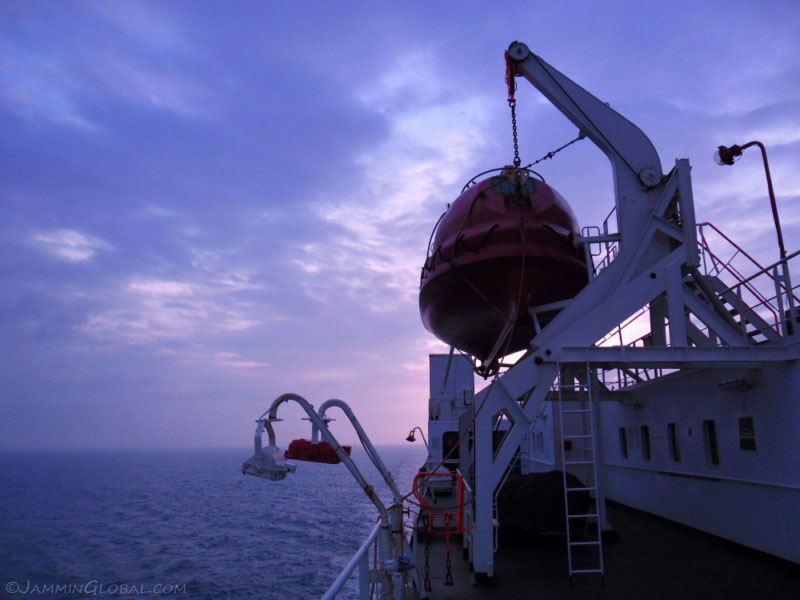
There are two of these big boats on either side and they are the primary escape vessel. It is an enclosed boat and each one can carry all the passengers and crew (totaling 42, but 37 on our trip) in case the ship is listing (leaning into the water on one side) and one boat is not deployable.
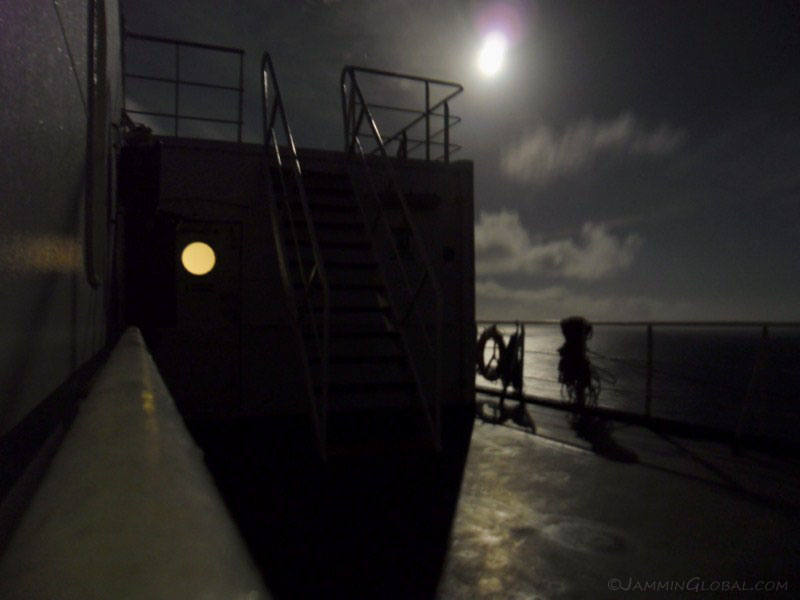
I headed out on deck every night after dinner and enjoyed the full moon in the early days of the journey. I was looking forward to tracking the stars and seeing how the constellations changed as we went from the southern hemisphere into the north. Orion would be the most obvious as his three dangling stars changed from him having a 'tie' in the southern sky to him having a 'sword' in the familiar northern constellation.
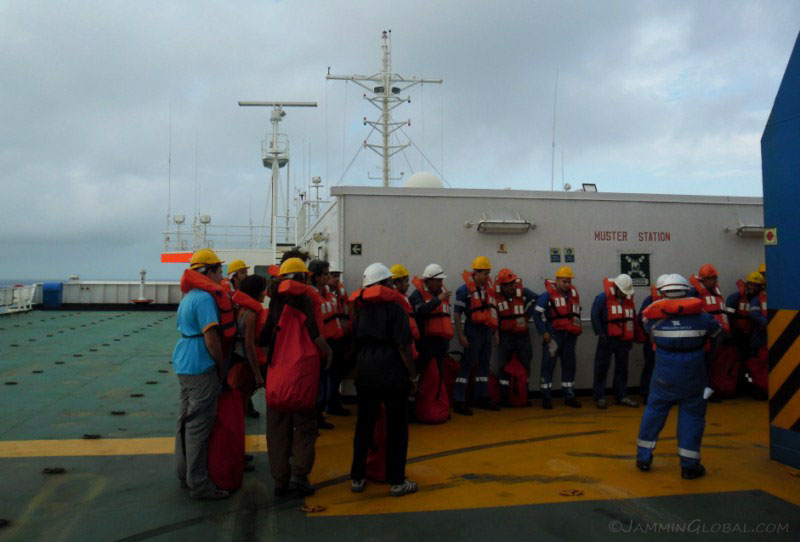
The first fire drill on board. They announce at lunch when the fire drill is going to sound, usually an hour before dinner. When it goes, you have to leave your cabin with hard hat, life jacket and cold water suit (in the red bag) and head to the muster station on the top deck where roll call is taken to account for everyone.
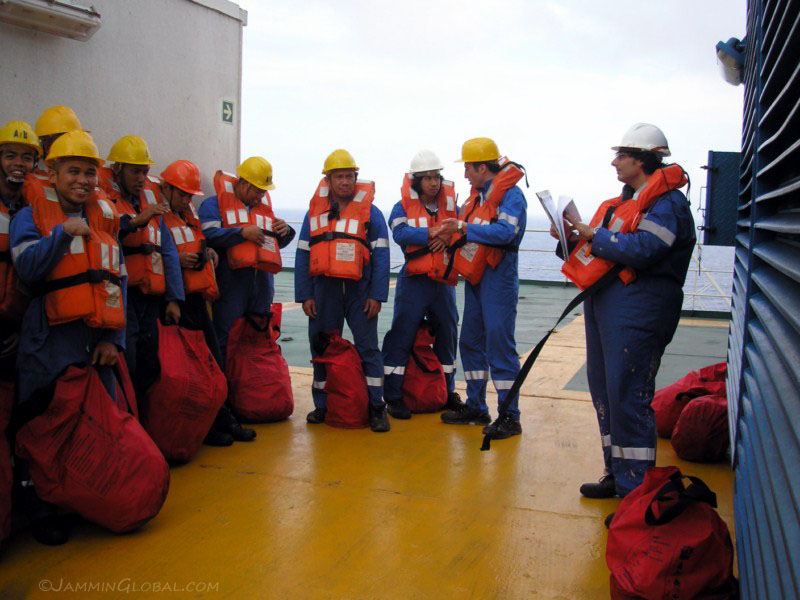
This was the first time we got to see all the crew members. Most of the officers were Italian and the rest of the crew was Filipino. I was told by previous passengers that sometimes the crew is Indian (meaning Indian food in the crew kitchen), but this time, no special food, just Italian. The Filipinos were mainly young guys, working either in the engine room or miscellaneous tasks around the ship. The officers were friendly, but there wasn't much interaction with them.
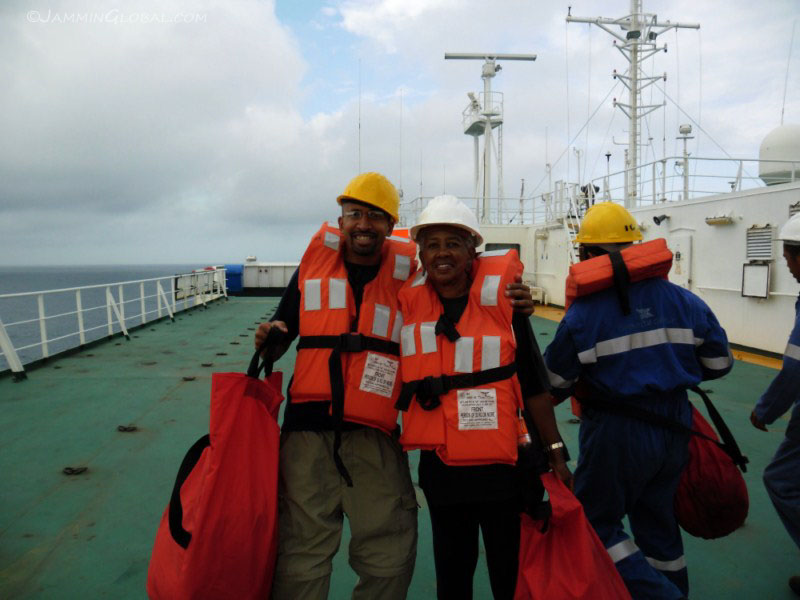
This is Jean, the 9th passenger, who's a retired lawyer from Washington, DC. Crazy woman would be spending two months on this ship. She did the southbound journey from Europe and was now returning. All the crew were amazed that a passenger would want to stay on board for so long. She was just traveling for the heck of it, exploring alternative travel instead of the usual cruise ships. Kudos.
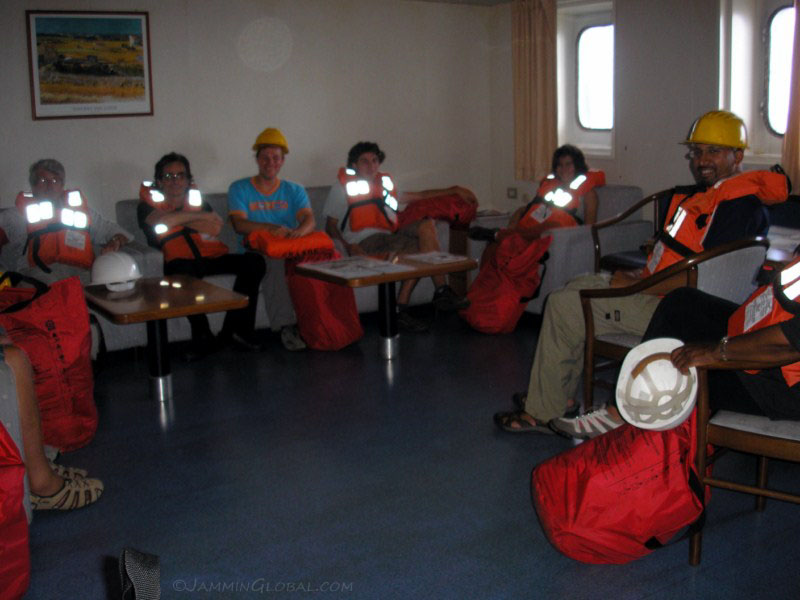
After roll call on deck, the passengers were made to wait in our social room, while...
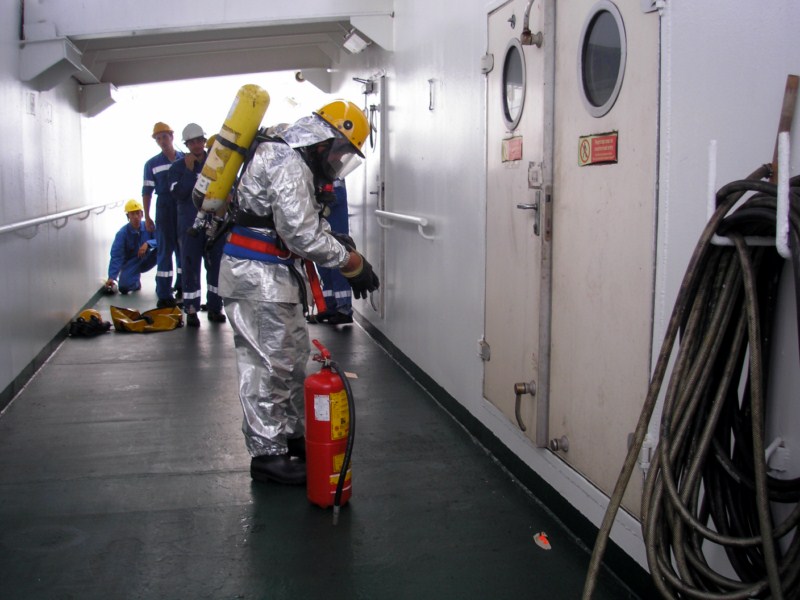
...the crew carried out additional safety drills. Photos provided by Officer Mantilla. Here, they're playing out the scenario of a fire in the kitchen.
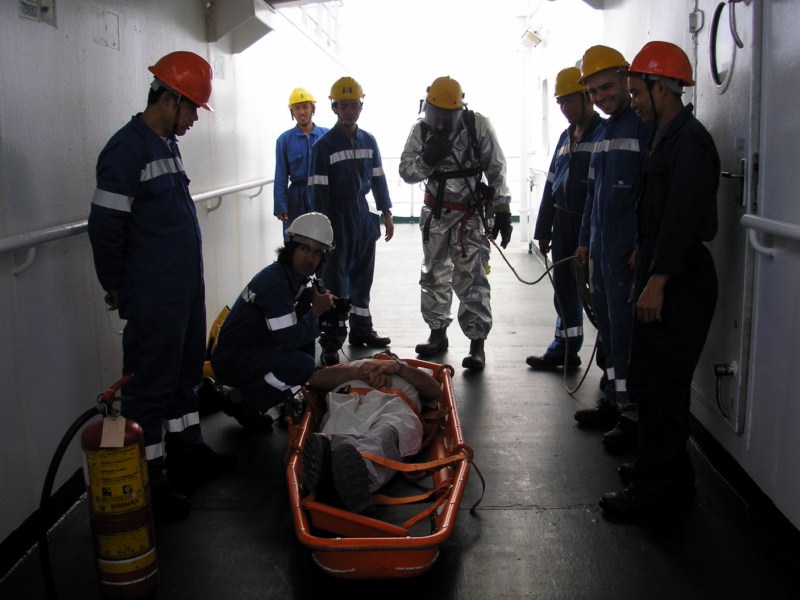
The cook was presumed injured and carried out on the stretcher. They take it very seriously, but smiles are breaking out.
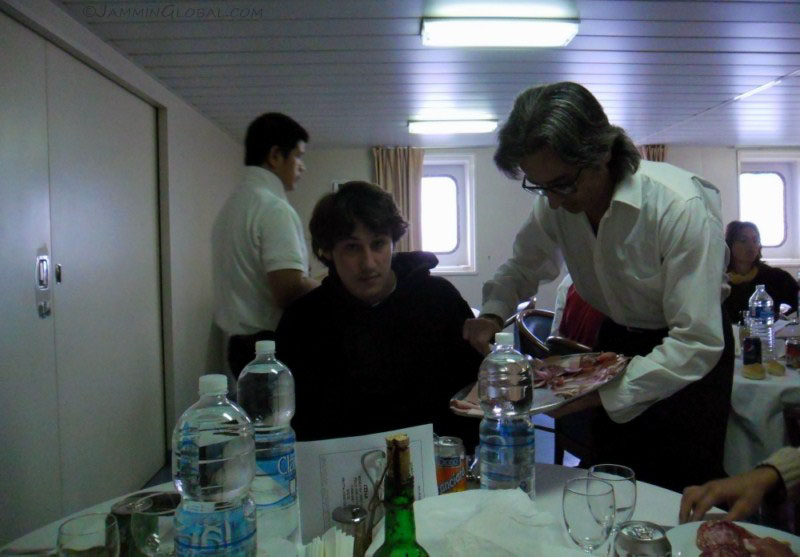
Dinner time. This is Franchesco, the steward responsible for the passengers and his assistant, Manuel in the back. The ship runs on a tight schedule and meal times are breakfast from 7:30 - 8:30 am, lunch from 11:00 am to noon and then dinner from 6:00 pm to 7:00 pm. Lunch took some getting used to, being quite early for all of us, especially after being in Argentina, where the meal times are skewed the other way (very late) but after a few days, we fell into the routine. He said lunch was so early because we had to clear out so that the officers could eat at noon, which was strange because all though this was the officer's mess, they had their own tables. Bottled water and wine or soft drinks were served with lunch and dinner.
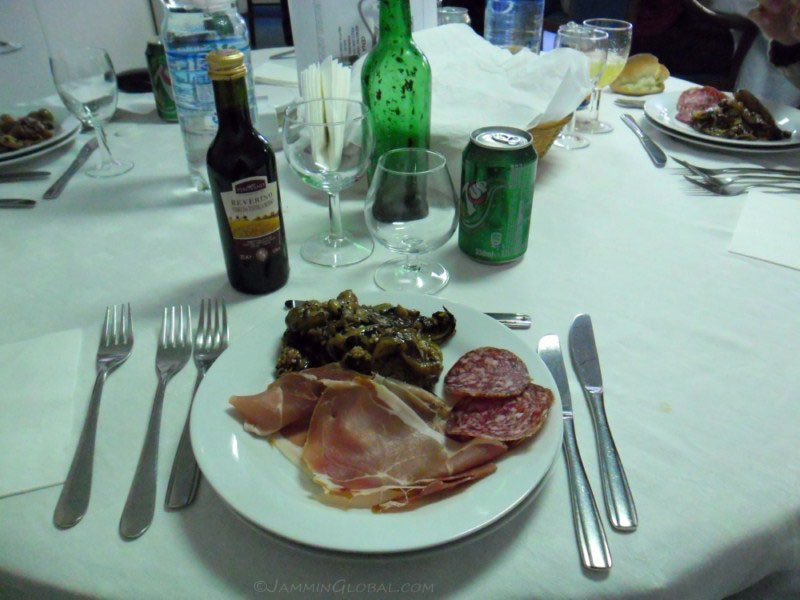
A tasty entrée of antipasto (cold cuts and eggplant in olive oil). The meals were very heavy and no one was left wanting for more food. I bought snacks for the journey and didn't even touch them. I definitely put back the weight that I lost from traveling.
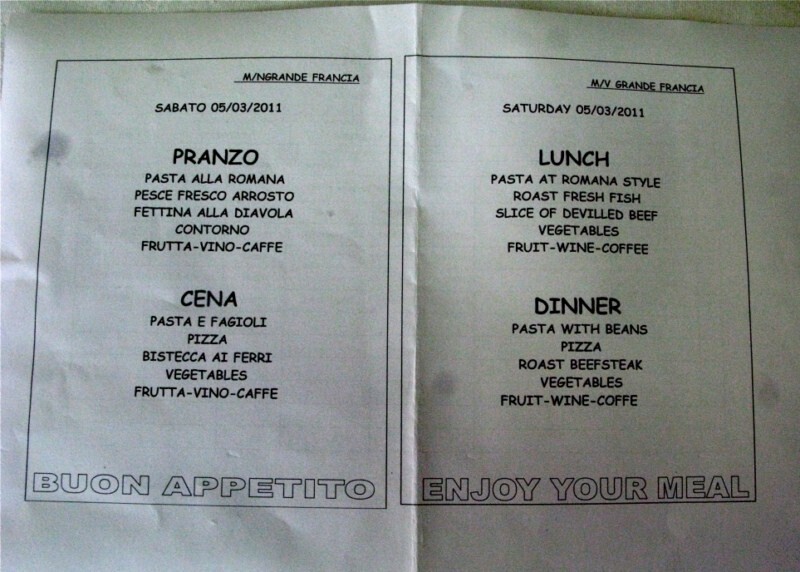
An example of a daily menu. Each meal started with a pasta dish, then there was a seafood course followed by a beef course. The vegetables refer to salad, which was just cut tomatoes and very white lettuce. Fruit was usually apples followed by excellent Italian espresso coffee or tea. I got tired of pasta and asked for a plate of rice from the Filipino dining room, which the other passengers appreciated too.
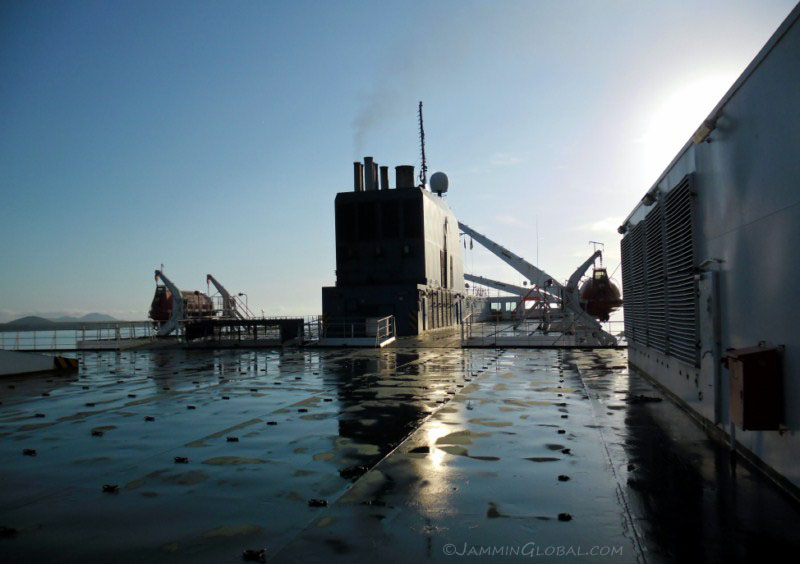
After a few days out at sea, we arrived in southern Brazil for stops at three of its main ports before making the crossing to Senegal. It had rained overnight.
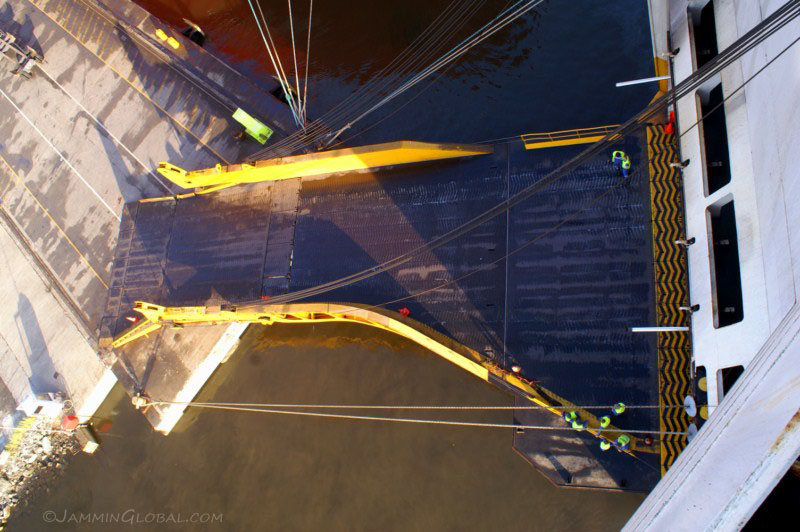
Looking down from the top deck, the ramp was down in Paranaguá ready to pick up some new rolling cargo.
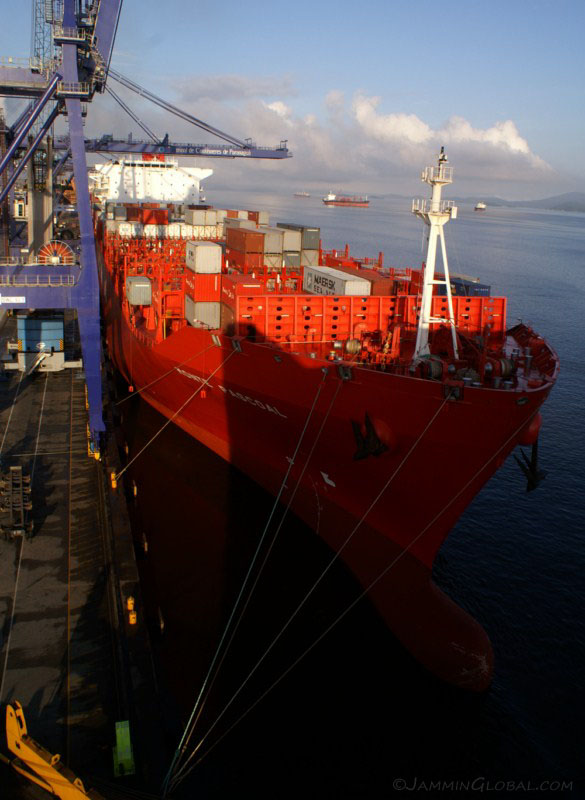
Right behind us was the Hamburg Süd ship, Monte Pascoal, a Panamax container ship.
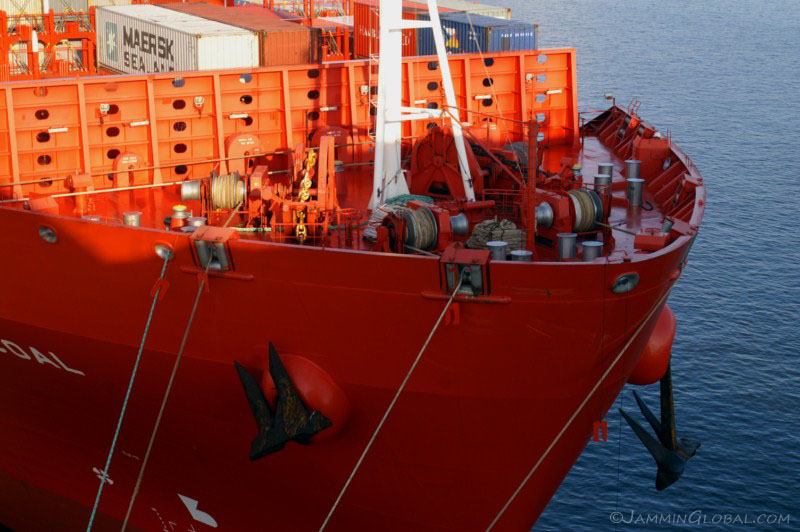
It was interesting to see how close we were docked next to another huge cargo ship. A closer look at its anchors.
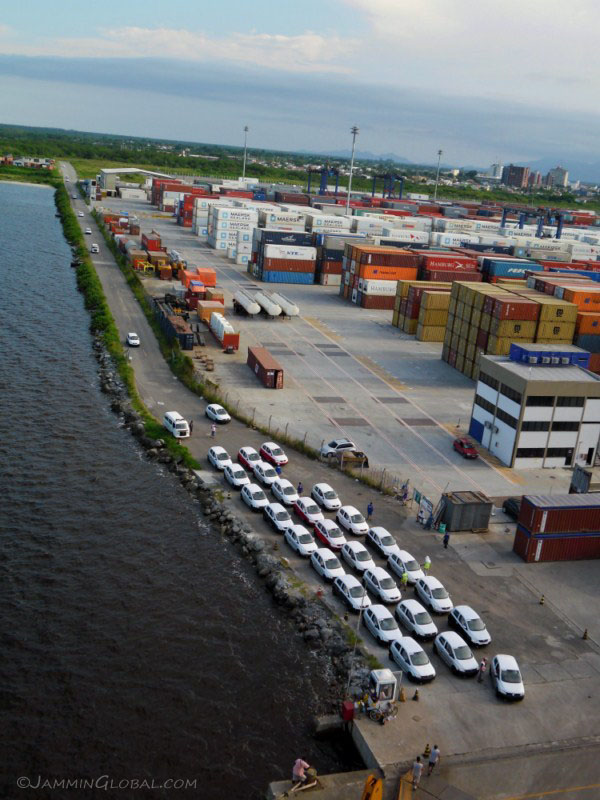
New Volkswagen compact cars, manufactured in Brazil, being transported to Europe.
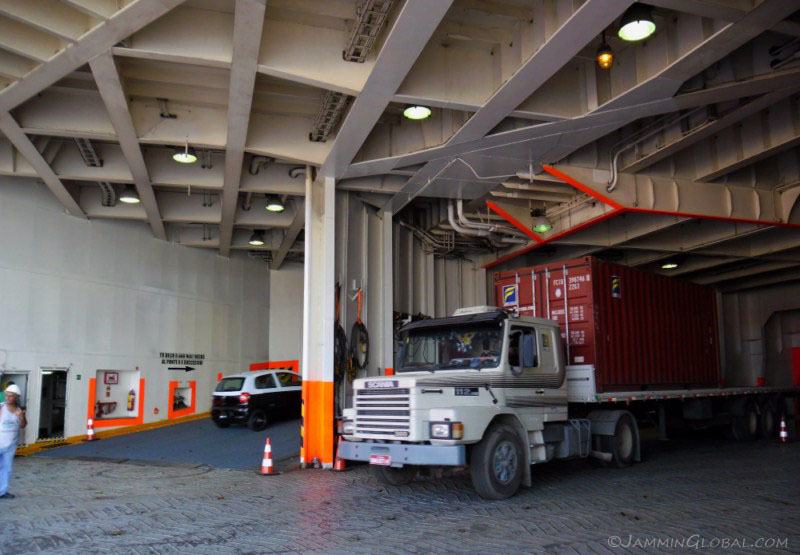
At the ship's main entrance, which was busy with cars driving up to their holding decks and trucks hauling out containers.

Another look at the Monte Pascoal and how close it was to the Grande Francia.
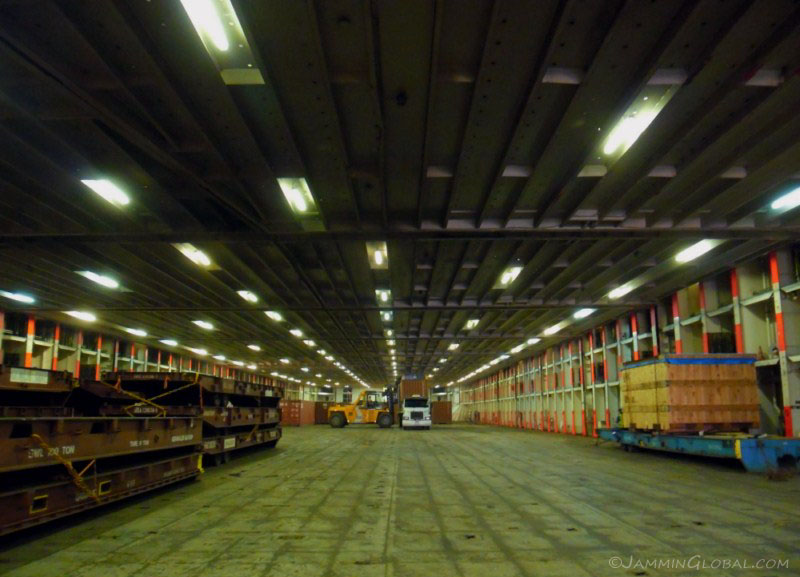
A shot inside one of the decks of the ship where a loader was placing containers on truck beds.
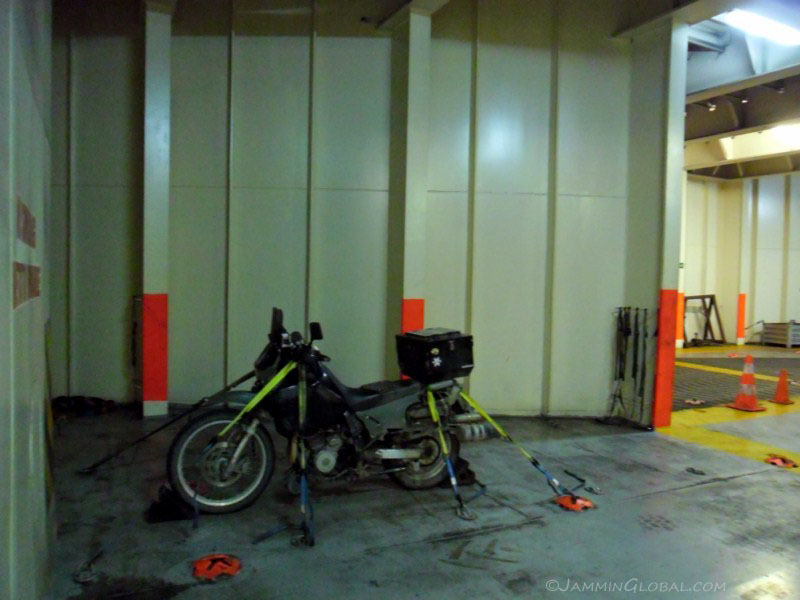
I strolled up to Deck 6 to check up on sanDRina. The ports in Brazil are pretty safe, regarding the vehicles on board, compared to some stories about damage and theft after visiting some African ports.
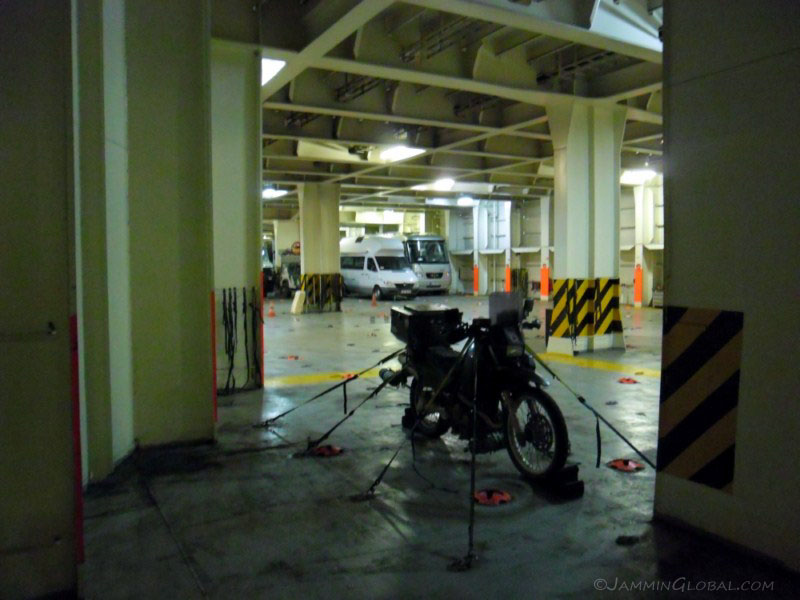
While the ship is underway at sea, the car decks are secured (locked) but passengers can still access their vehicles with an officer escort. However, while at port, the decks are open and you are free to walk around.
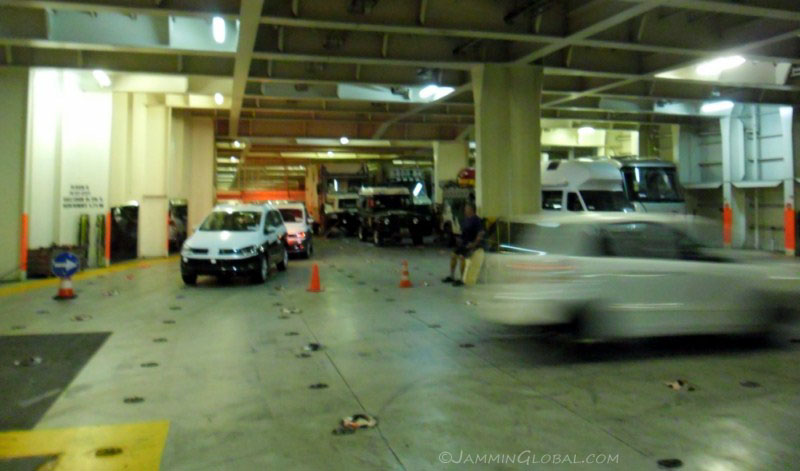
Some Volkswagens were rolling off while others were rolling on. It was a hive of activity as it takes quite a while to move so many vehicles on and off the ship.
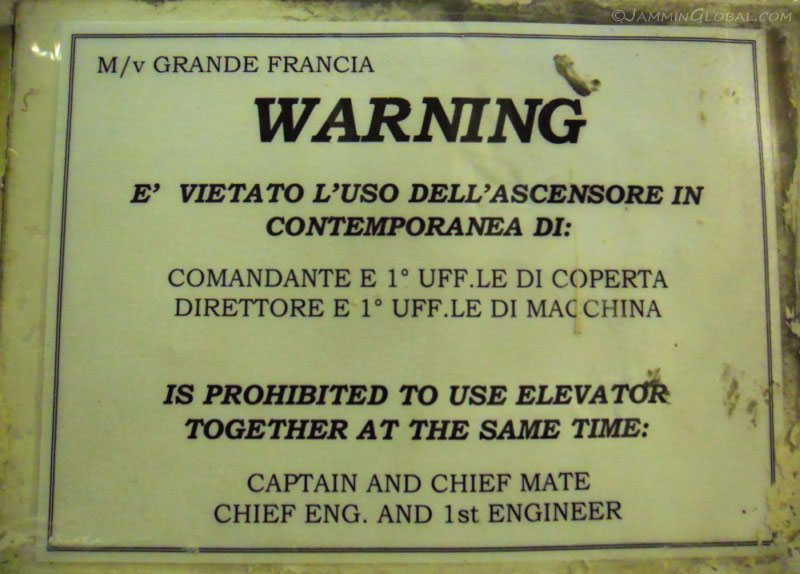
Walking around the ship, I noticed many signs posted about. This one wants to ensure that the first and second in command of the ship's operations (captain and chief mate) and engine room (chief engineer and 1st engineer) don't get trapped together in the elevator, leaving it to lower ranking officers to run things. The same thing applies to corporate officials where say the CEO and another high ranking official are not allowed to travel on the same plane together so in case it crashes, the company doesn't lose too much leadership. For the minions (regular engineers), the company had a policy that no more than 10 of us could be booked on the same flight.
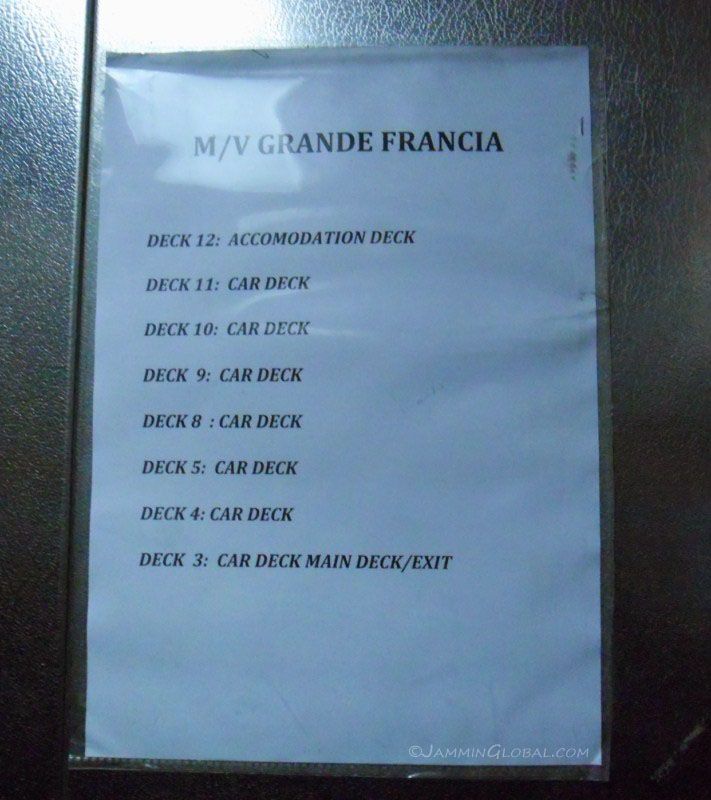
Inside the elevator. Our vehicles were on Deck 6, so we had to take the elevator to Deck 5 and walk back up. The M/V prefix in the name of the ship refers to 'motor vessel', as in, powered by diesel.
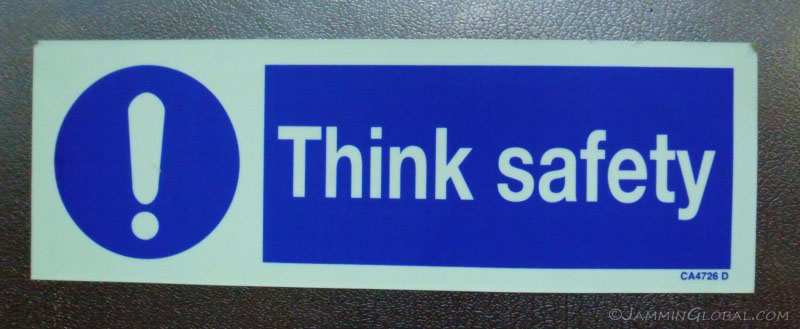
It's all about safety on board.
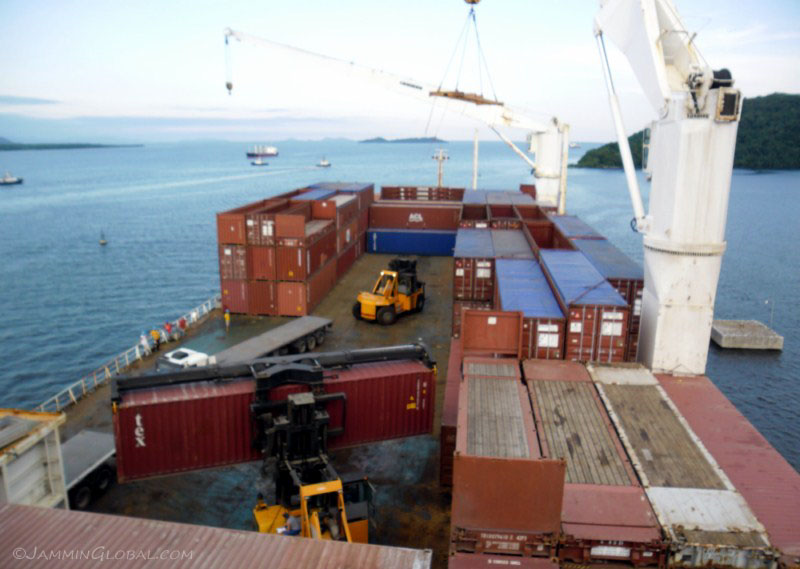
Besides driving containers into the hull, some were also driven to the deck out front. It was nice to see the tightly coordinated maneuvers.
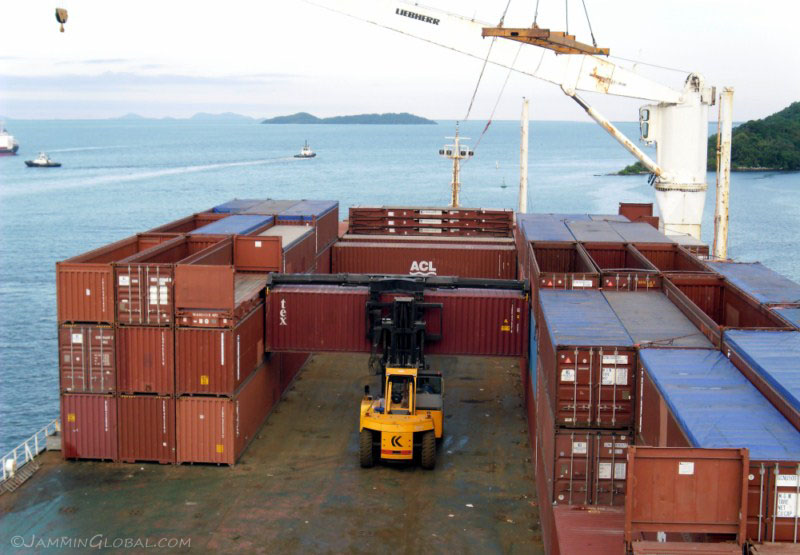
Sliding a container with very little room for play. However, it wasn't all smooth with lots of banging and scraping.
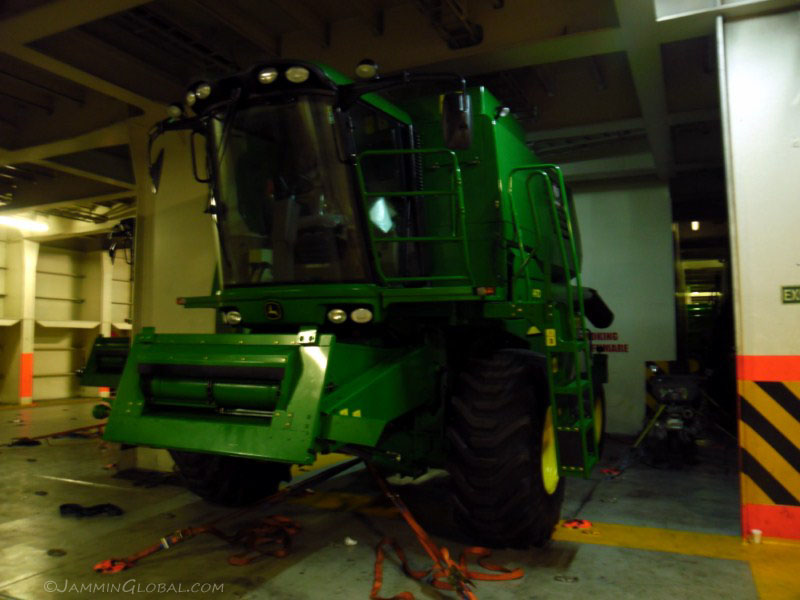
At the end of the day, I had one last look at sanDRina and was surprised to see her new deckmate, this huge John Deere 1470 combine, manufactured in Brazil, heading to Germany. I think the bike could easily fit inside one of those tires. This is the high and heavy load deck, suitable for these 10 tonne machines.
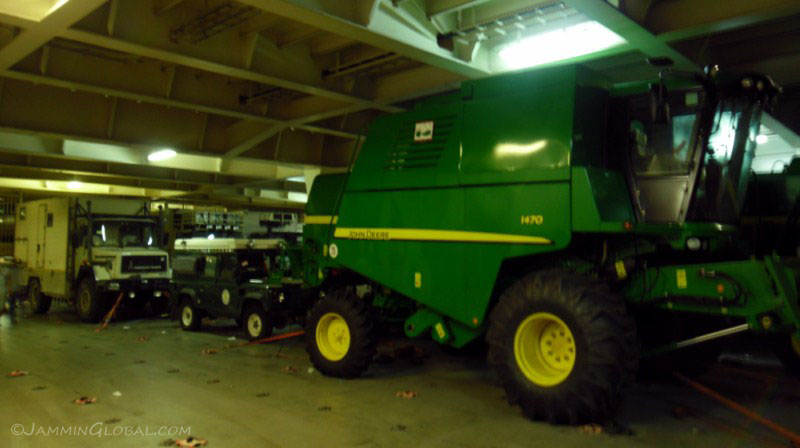
Looks like it spits out Defenders out the back. Even the huge Unimogs in the back look tiny compared to this behemoth of a machine. So, this is what industrialized agriculture looks like these days.
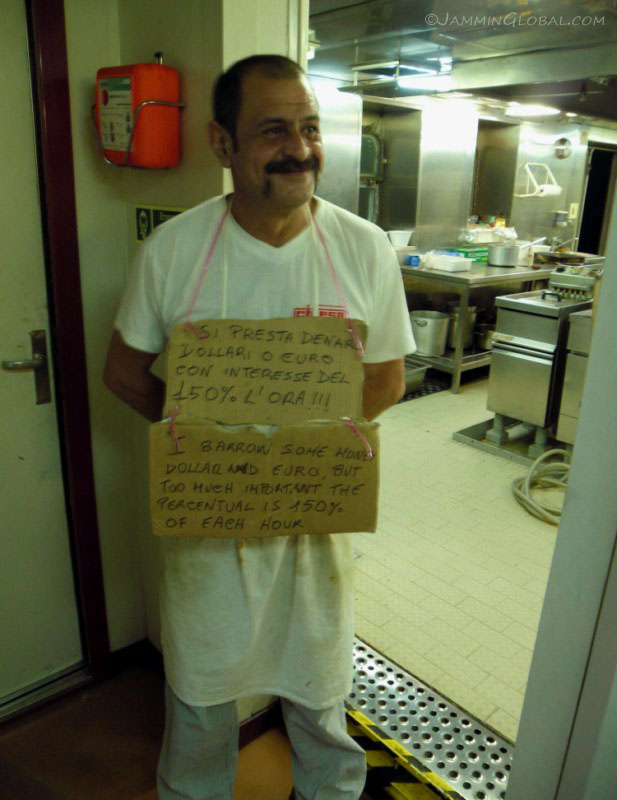
The cook, Nicolai Barba was a funny and light-hearted man, but still rough around the edges. We always thanked him after dinner ('grazie mille') and here he's standing outside the kitchen with a sign saying that he will lend you money in dollars and euros but the interest rate is 150% per hour. When he found out I was Indian, he happily showed me his huge bag of Madras Curry Powder and that started the process of seeing if I could cook my chicken curry in the ship's galley. It would take some time to make it work since passengers aren't allowed in the kitchen, due to safety issues.
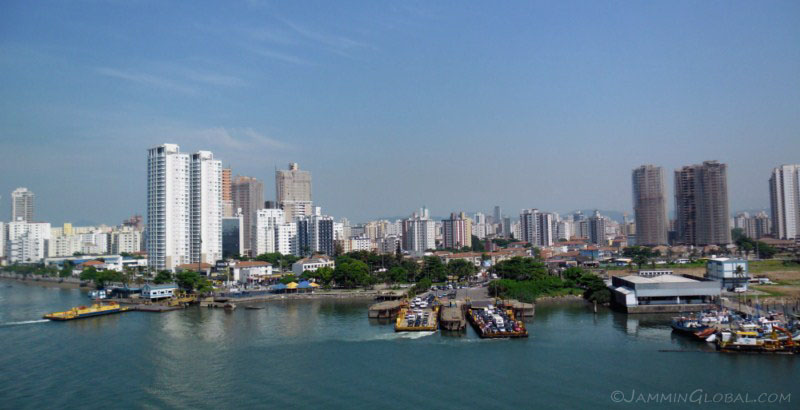
After an overnight journey, the next morning we pulled into Santos, the big port city linked to São Paulo.
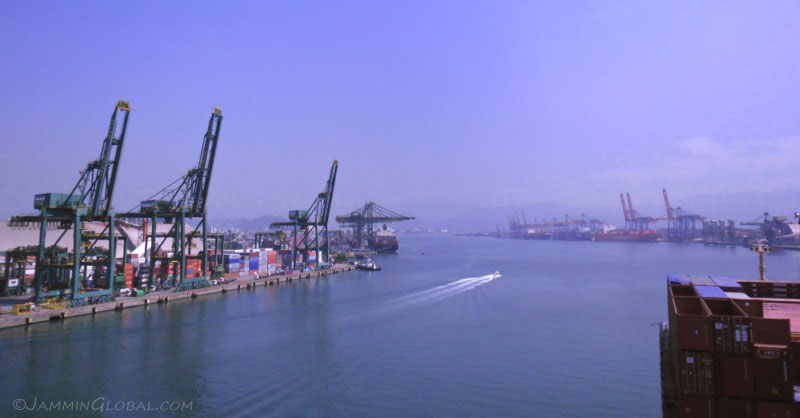
Sailing up the harbor, which was on both sides of this channel leading to the Estuário de Santos.
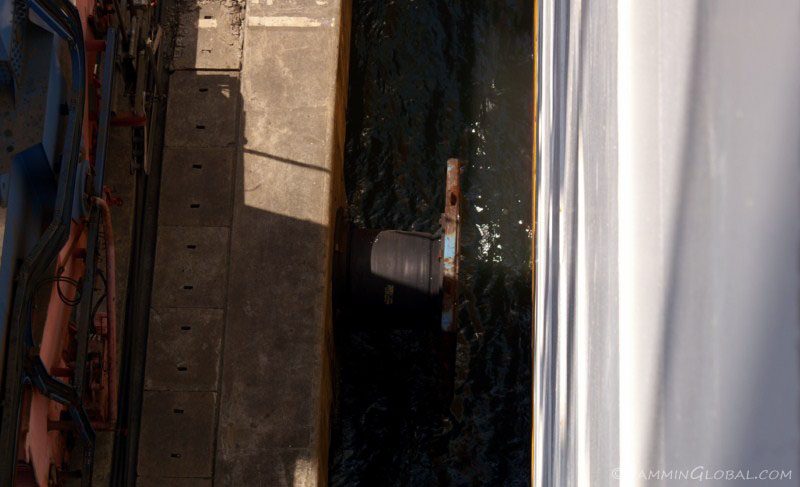
Slowly maneuvering this huge ship with the side motors to kiss the port bumpers. It was impressive to see how precisely the ship could be maneuvered.
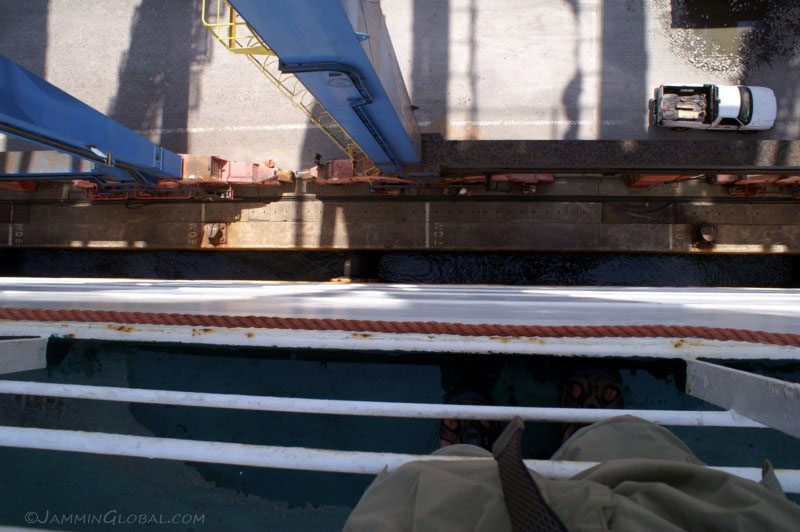
Docked at Santos.
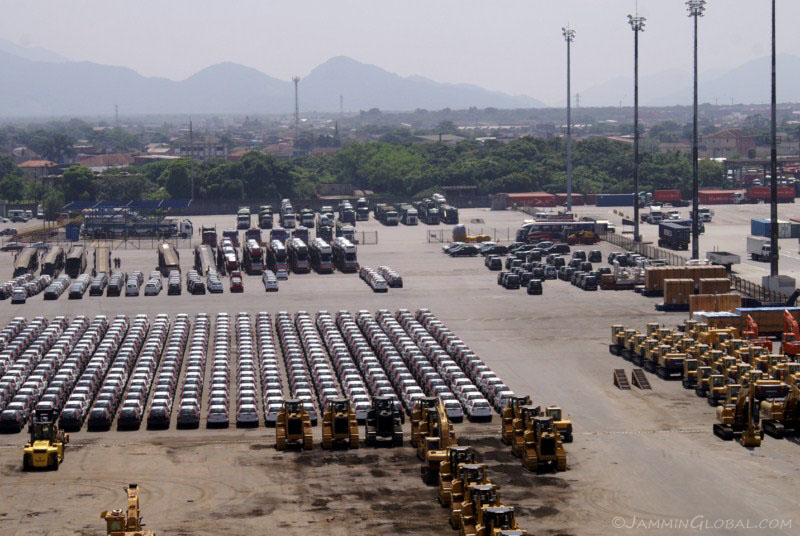
Brazil's economic might really shows through on this tour of its huge ports. Hundreds of cars and construction equipment waiting to be loaded onto ships. Not all of it was for our ship.
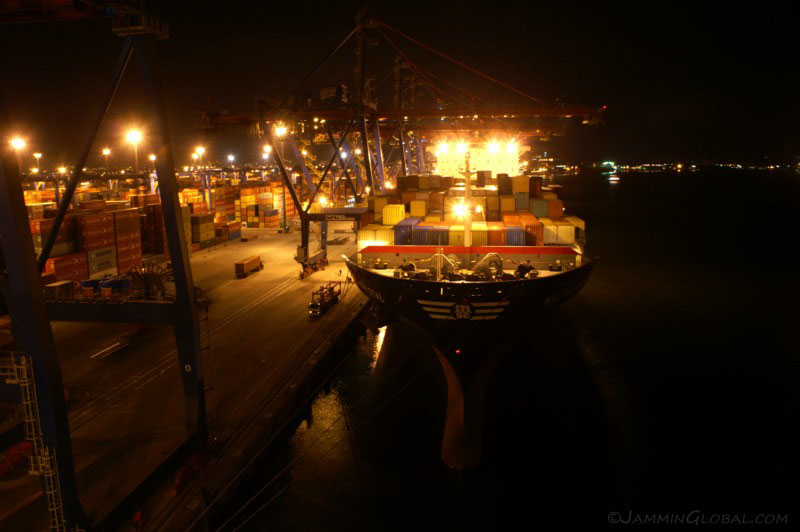
We were in Santos into the evening and here's a shot of an MSC ship, which was docked behind us.
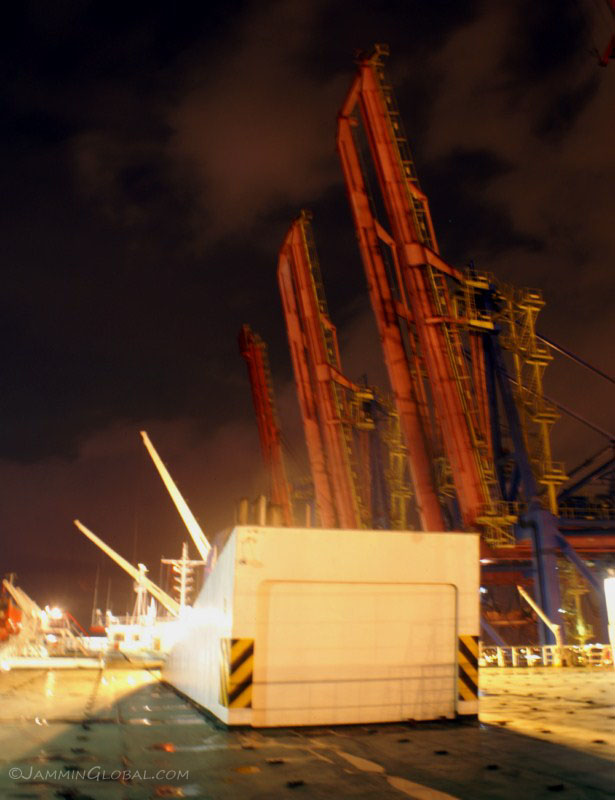
A view from the top deck of the access door for vehicles and the monstrous cranes towering overhead.
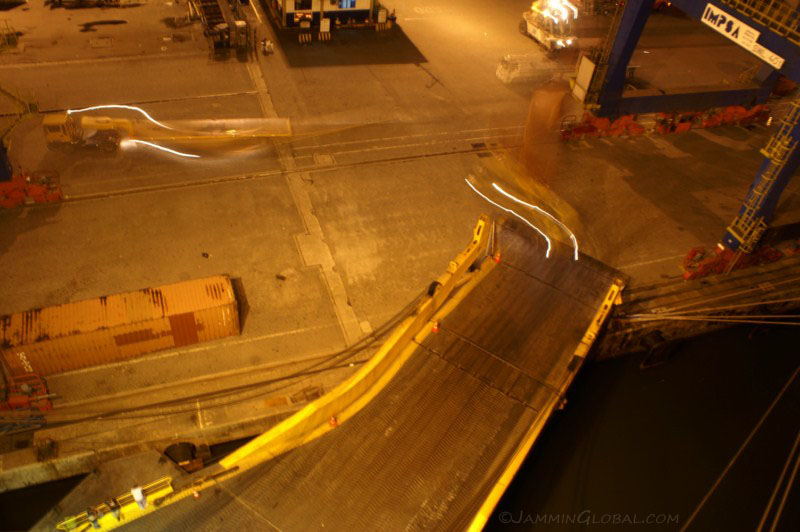
Catching the dance of the port trucks moving containers into the ship's hull.
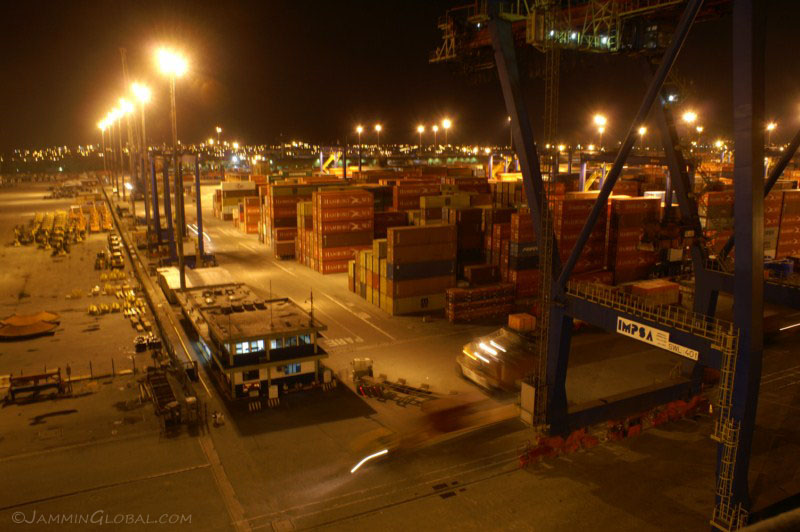
Traveling by cargo ship gives you a nice insight into the freighter side of our world, which is usually not visible to the public. Most of the goods in the world travel by sea and this keeps the global economy swimming along.
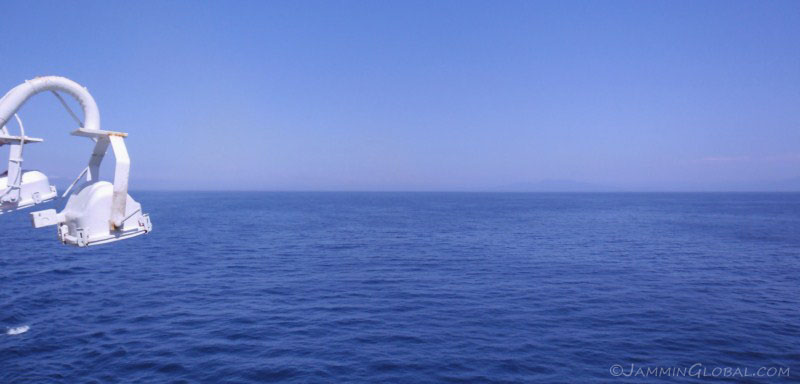
The next morning, we were cruising close enough to see land and I saw on my GPS that I was looking at Picinguaba, my fishing hamlet slice of paradise in southern Brazil. Oh, how I yearn to be back there...

A few hours later, we had the grand view of seeing the marvelous city of Rio de Janeiro from sea. Left to right are the beaches of Ipanema and Copacabana with Corcovado (Christ the Redeemer statue), the highest peak in the middle, finishing off with Pão de Açúcar (Sugarloaf Mountain). I enjoyed my ten days that I spent in Rio, back in October and was happy to be back in this unique city with its varied geology and happy people. The view from shore was impressive enough and now I could marvel at her from sea.
Click here to see the high resolution version.
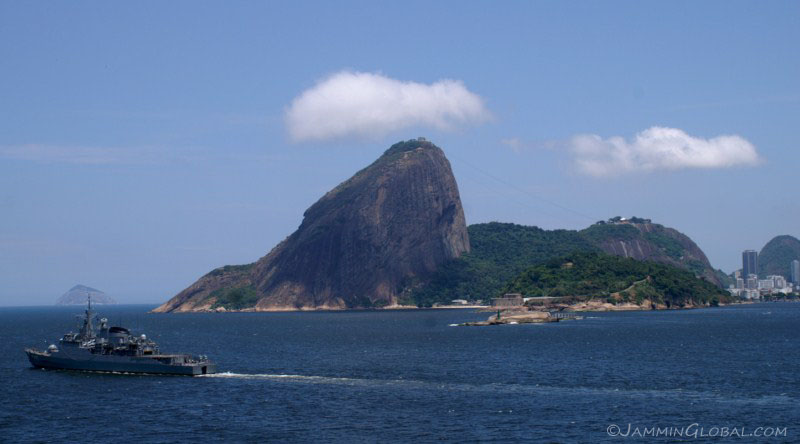
Sailing around Pão de Açúcar and heading into Guanabara Bay, the natural harbor that Rio sits on that made it an important city in the early days of colonization in the 16th century. The 396 m (1,299 ft) granite peak jutting out of the water creates enough of a disturbance to the winds to have it owns clouds at the top.
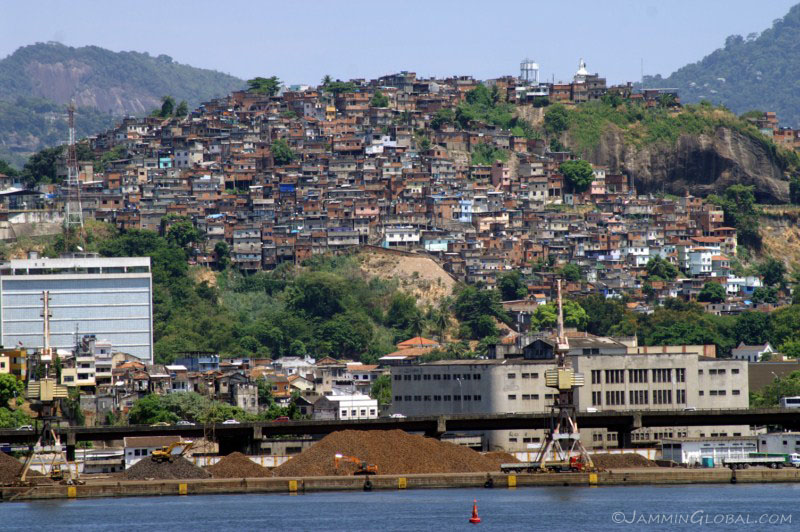
A view of one of the favelas of Rio, covering this steep hilltop. Favelas are part of most big Brazilian cities, but the ones in Rio are unique because these poor areas are very close to the rich areas of town due to the rocky geography of the city. A lack of space in the flatlands, where the rich people live has driven the faveladors to make home on the steep hills. Besides being trapped in poverty, living on the steep hills leaves them vulnerable to the frequent mudslides during the rainy season that shows up regularly in the news. Instead of referring to them as a slum, the word 'comunidade' (community) is more appropriate these days, but sadly they are still easy targets for the crime gangs that Rio is trying to get a handle on before the 2014 Football World Cup and 2016 Olympics.
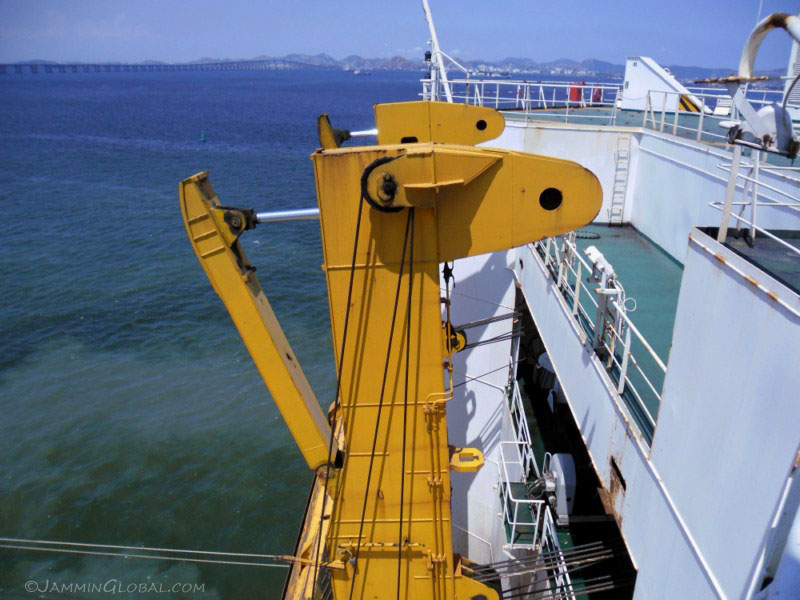
Once docked at port, the huge ramp is lowered down. You can see the dirt stirred up by the ship's propeller in the waters of Guanabara Bay, which were once pristine and had a rich ecosystem with mangroves along its shores. However, the constant urbanization and inevitable pollution that comes with it, along with an oil spill in the bay in 2000, has dealt a big blow to biodiversity in the bay.
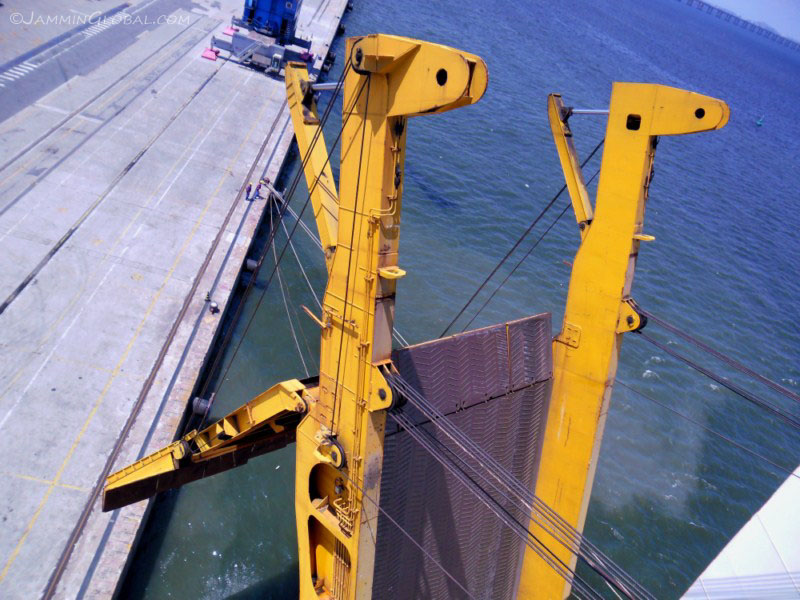
About halfway down, the lower part of the ramp swings out from underneath and flattens out as the ramp is lowered the rest of the way.
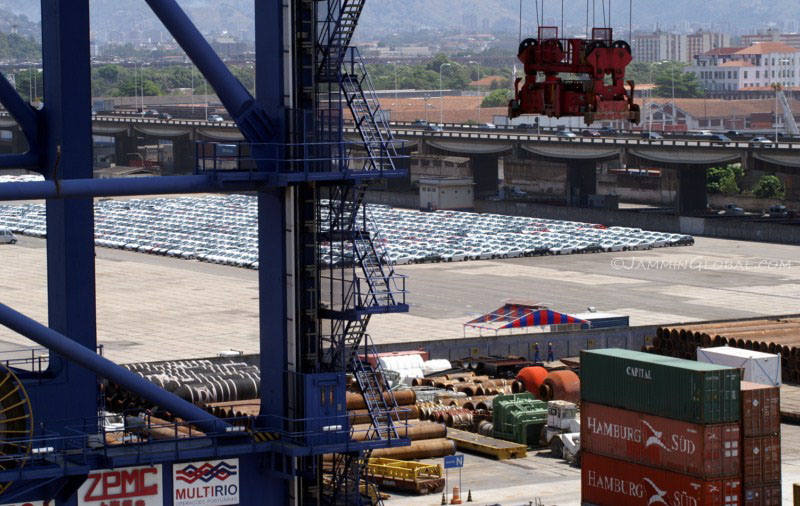
Another Brazilian port and another thousand odd cars waiting to be shipped out. There ain't no recession here.
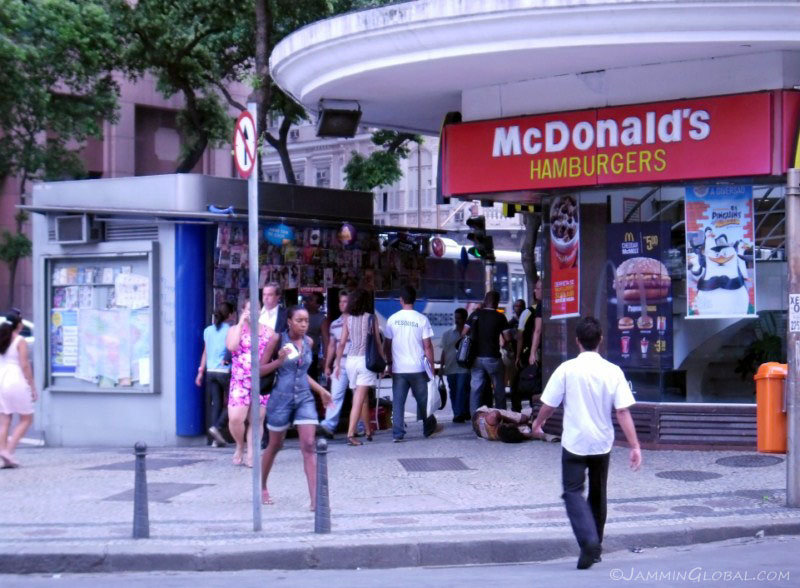
I walked into town and noticed this homeless man sleeping in front of a McDonald's with streegoers passing by. Since I had already visited Rio earlier, I wasn't up for the rushed tour around town that some of the other passengers went on to get their first glimpse of this beautiful city. At each port, if the captain decides it's safe enough, the passengers are allowed to get down for a few hours and generally have to be back on board about 2 - 4 hours before the ship sets sail.
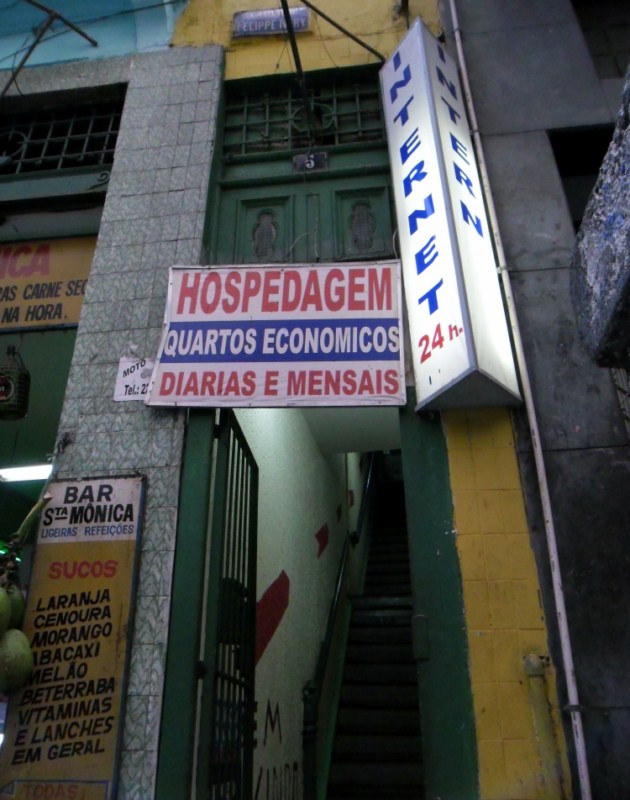
I mainly went on shore to get some internet, as I was eager to keep track of developments in the Middle East to see where the Arab Spring was spreading to next and whether it would affect my plans for Africa. There is satellite data access on board but it's mainly for ship communications. However, they let passengers use their email system with a limit of 2 KB per text message per day, which is not bad. I got the feeling that if we abused the system, then they would make us pay for it, but we used it sparingly, then all was good.
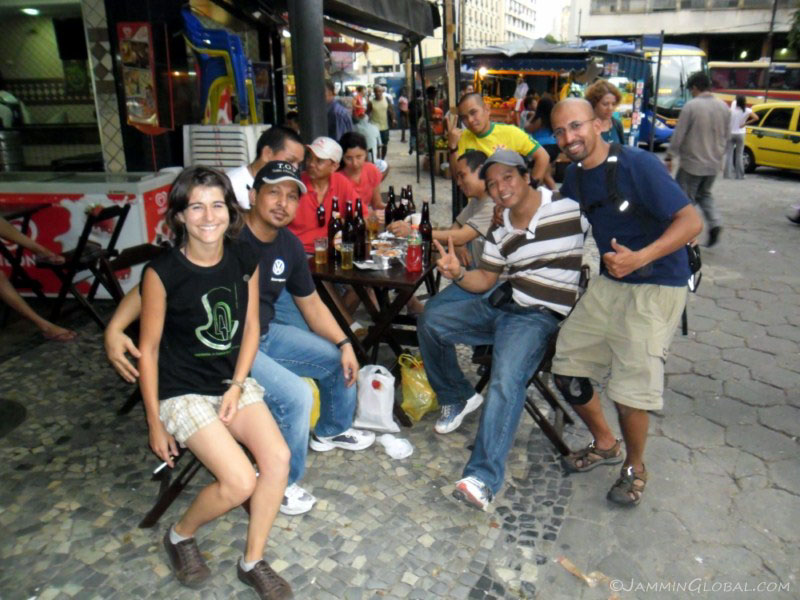
I was walking around with Marie and Anthony and we came across some of the Filipino crew who were having a day off on shore and relaxing with some beers. Very friendly guys. They invited us for a drink but the French couple wanted to get back to the ship in time for dinner.
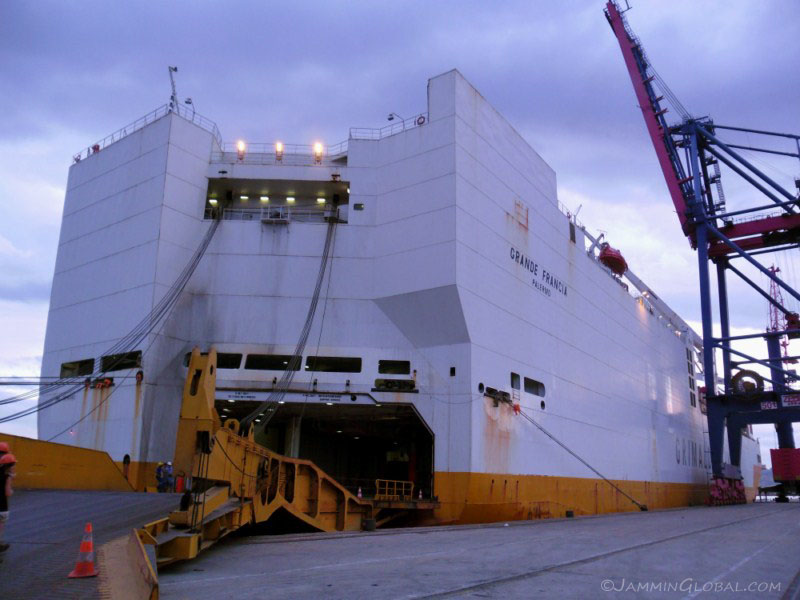
Walking back to our huge, floating, metal home on the seas, the Grande Francia. It was an interesting feeling to be able to see the ship while I was in town and reflect that unlike all the other people around me who were busy hurrying back home, I would be getting on a ship to sail across the Atlantic tonight.
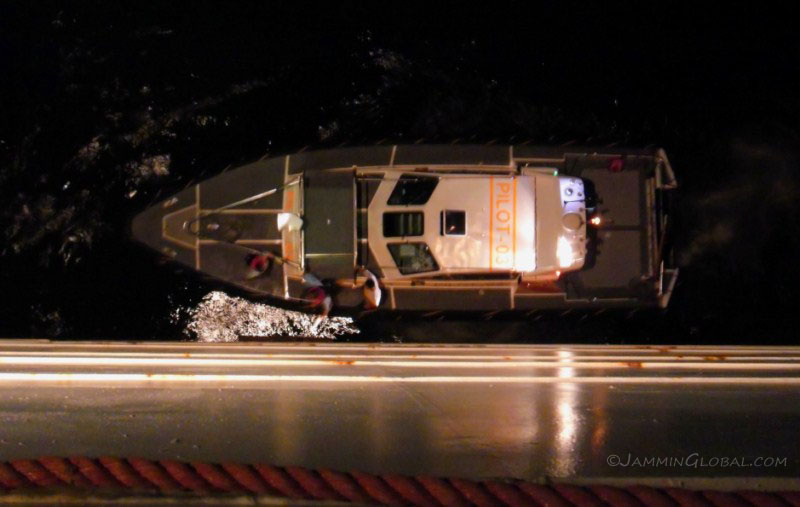
After dinner, we got on the top deck to see the push-off from Rio. After waiting a while, the harbor pilot boarded the ship, without whom ships cannot move in harbors and ports. A maritime pilot is a mariner who guides ship through busy waters, typically a port or harbor. It's one of the oldest, least-known professions, being used since ancient Greek and Roman times. In relation to aviation, it's basically like having a dedicated air traffic controller on board to guide the ship out to sea. The pilot's job is quite tricky as he has to board the ship while it's still moving out at sea. Even if a ship's captain (the master) has been to a known port a number of times, a pilot is still required as he has knowledge of the local currents, tides and any other changes in the port, which are not always evident in the nautical charts. The master is still in control of the ship, but the pilot guides him around any obstacles. Another crucial role of the pilot is in relieving the master of any economic responsibility of damage while in port.
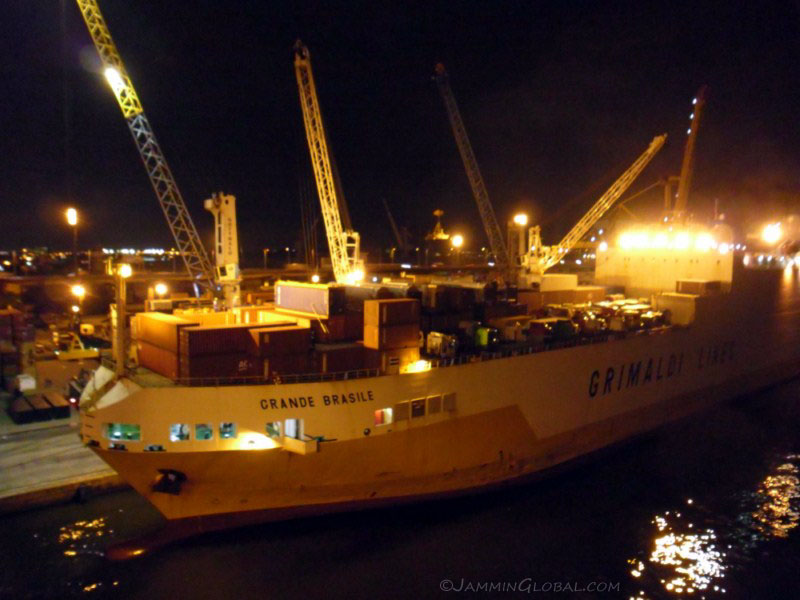
We moved away from our berth and then went backwards into the main waterway, passing a sister ship, the Grande Brasile, which is of the same Grande Africa class as our ship.
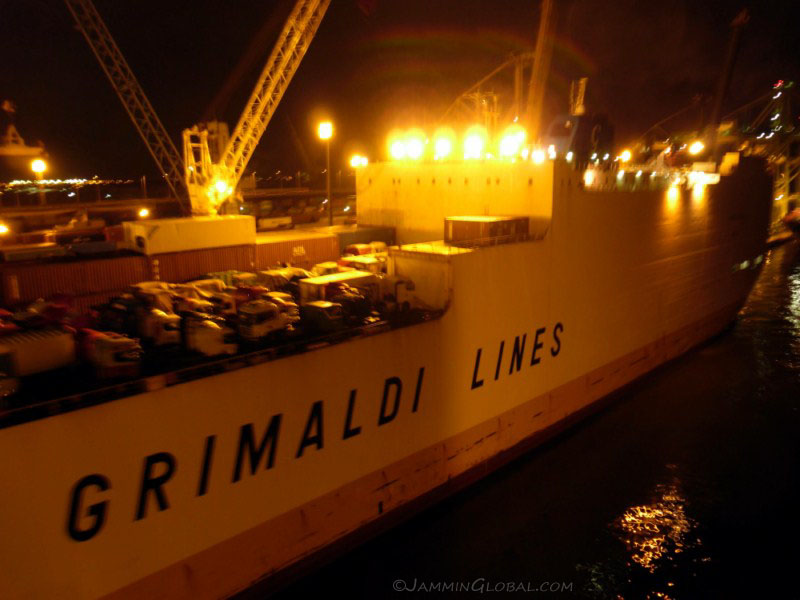
The Grande Brasile had lots of used trucks on board and usually when the ships come from Europe, they bring used cars and trucks to dump them in less stringent economies, where emissions and pollution aren't that tightly regulated.
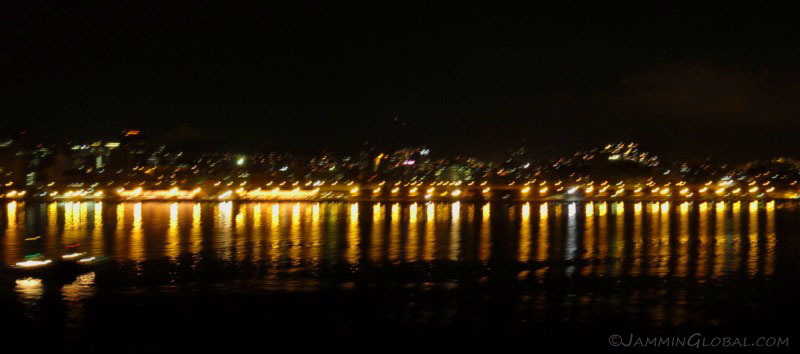
After making a 90 degree, on-the-spot turn, we cruised out of Guanabara Bay and bid farewell to Rio and finally to the South American continent. From here, it would be 9 days across the Atlantic to Dakar in Africa.
Next: Grimaldi, Part 2: Crossing the Atlantic Ocean to Dakar
Previous: Argentina, Part 6: Bahia Blanca, Azul and Buenos Aires